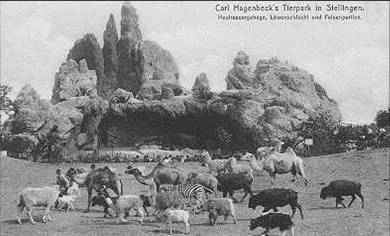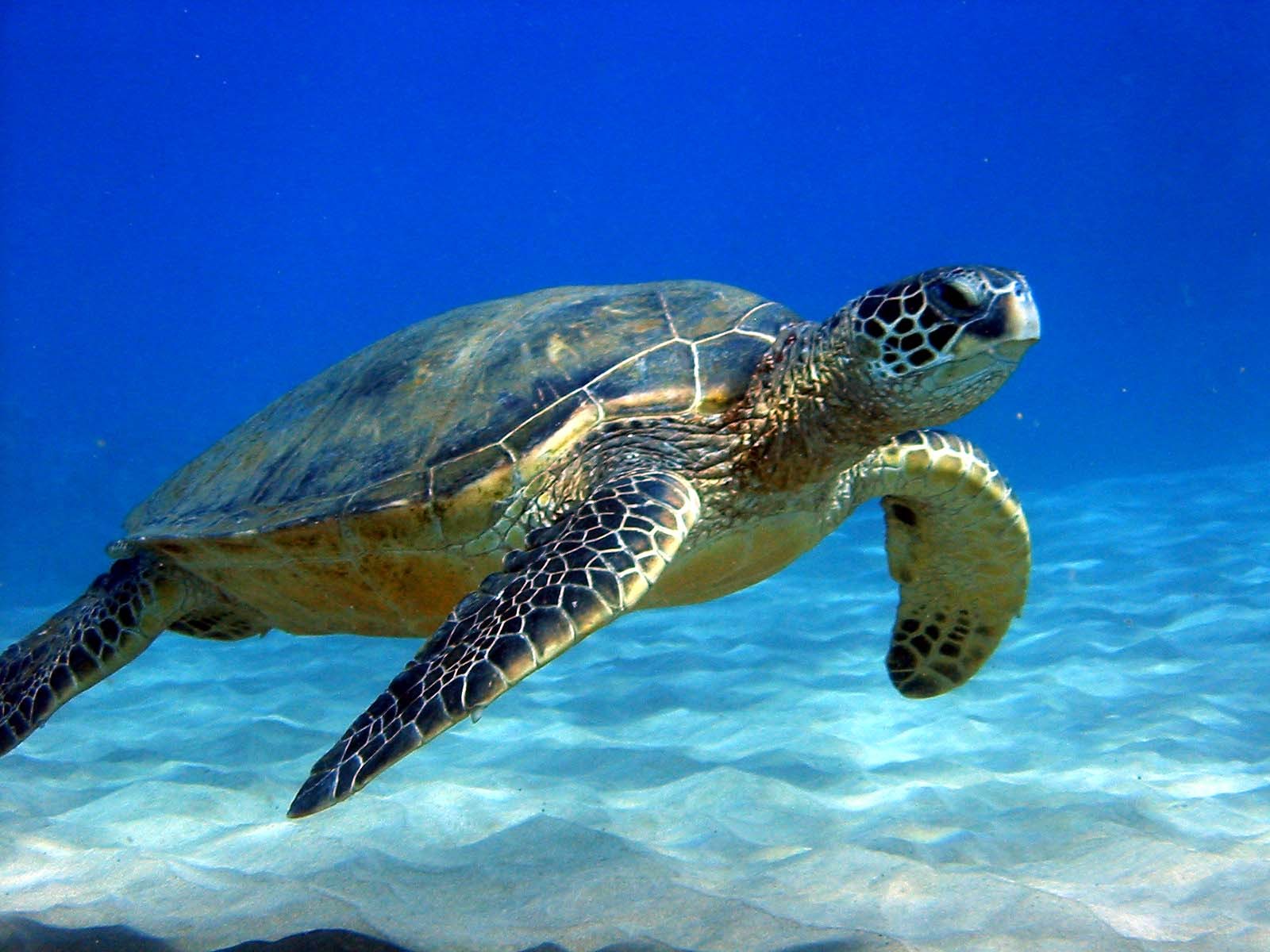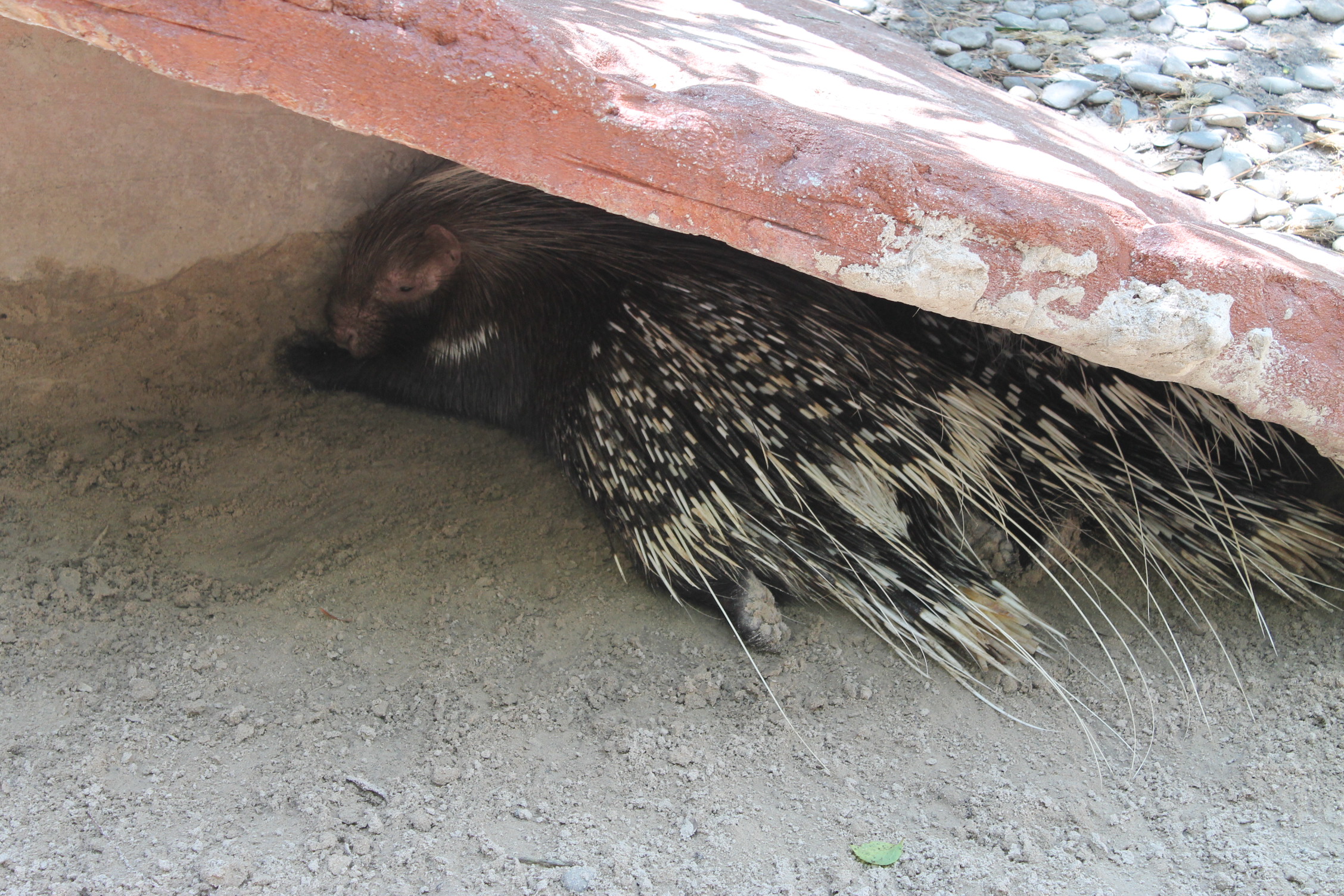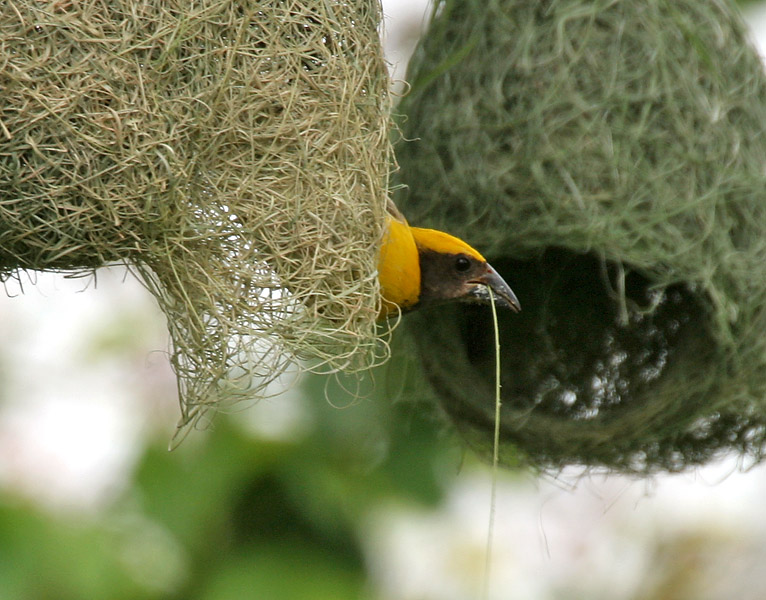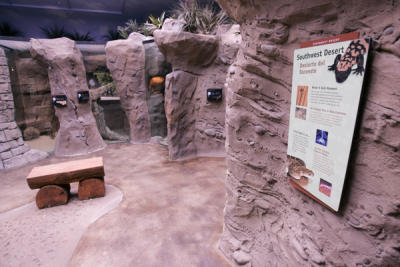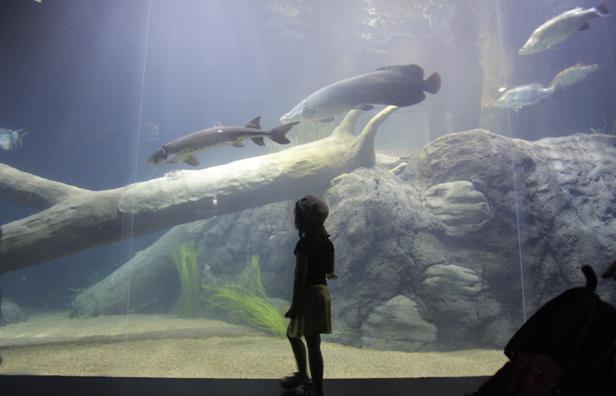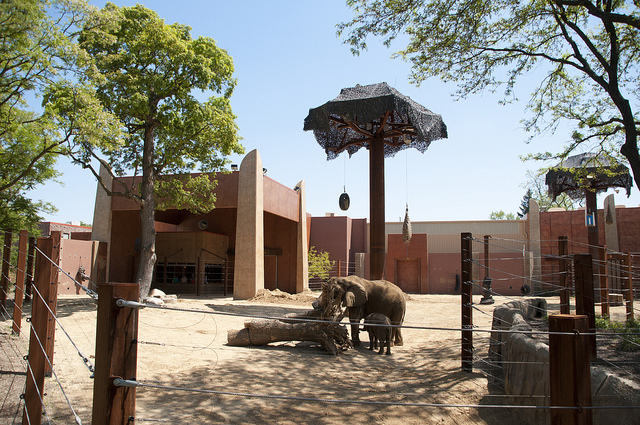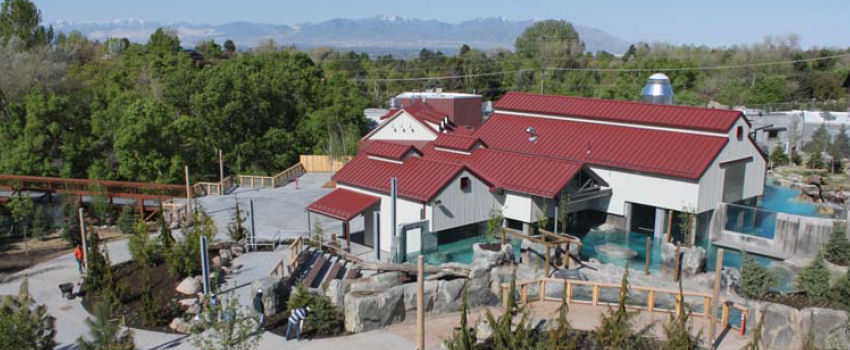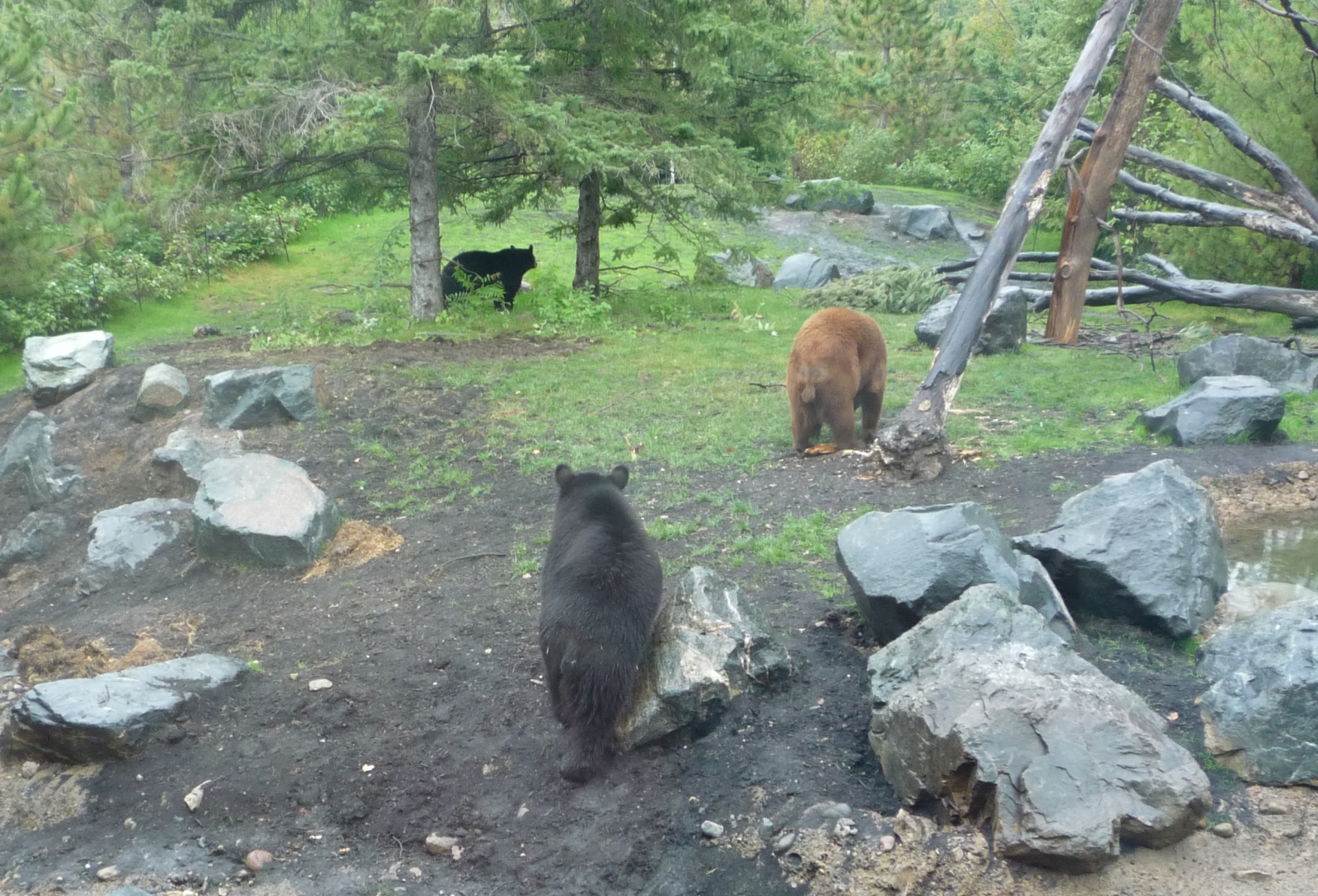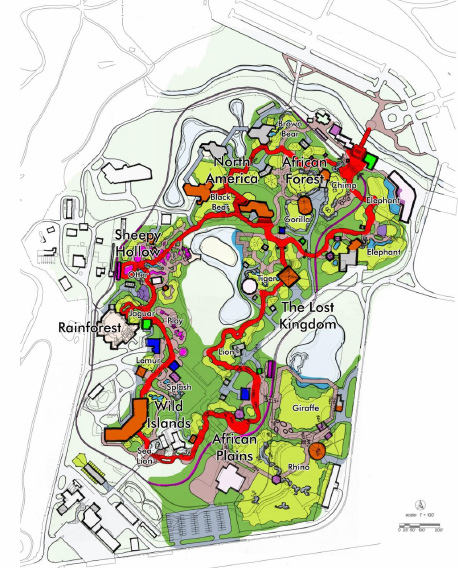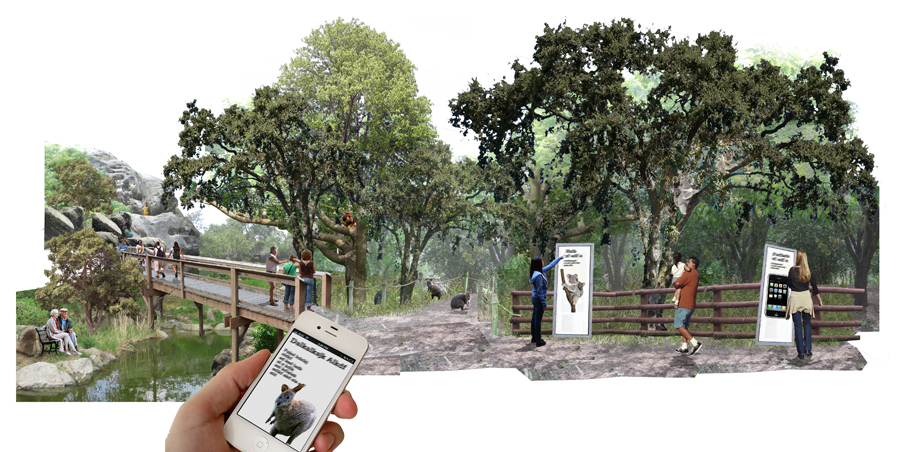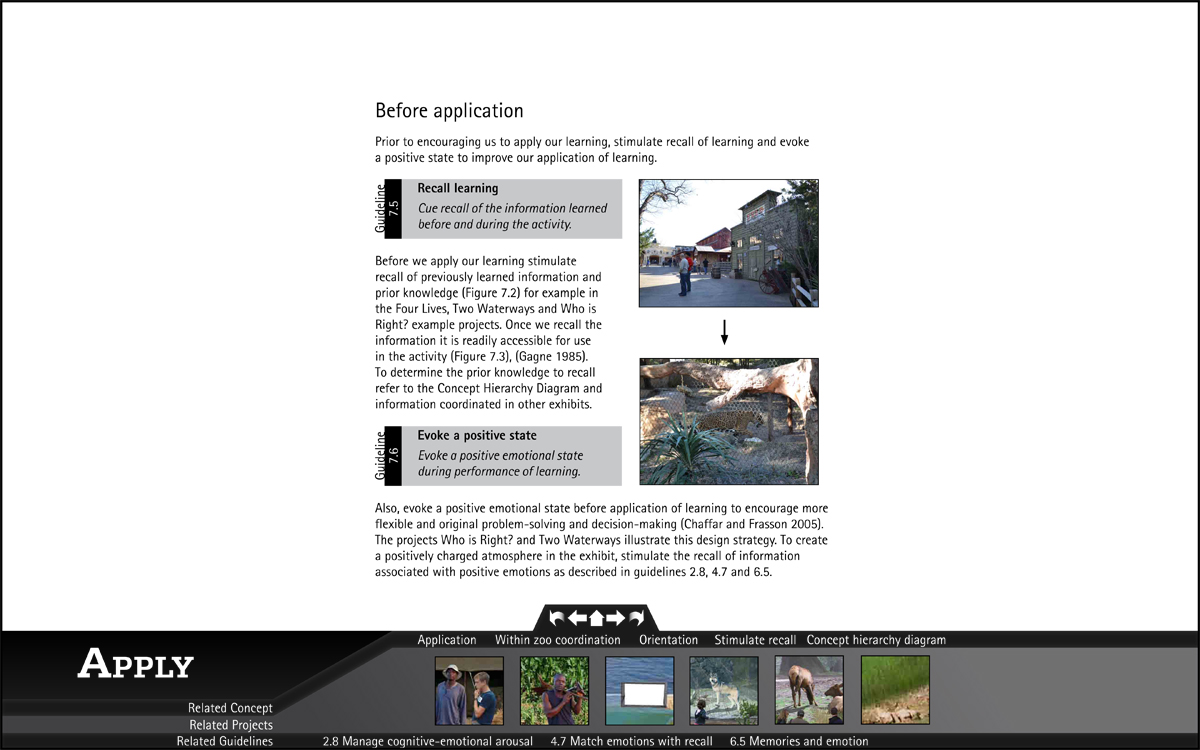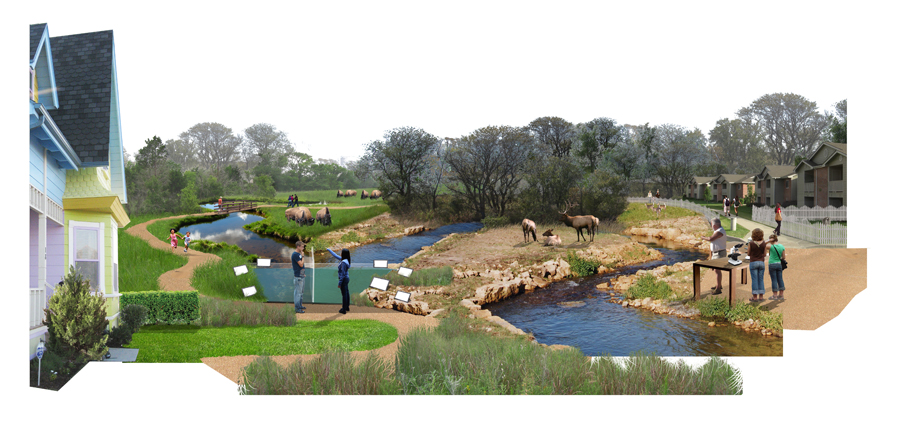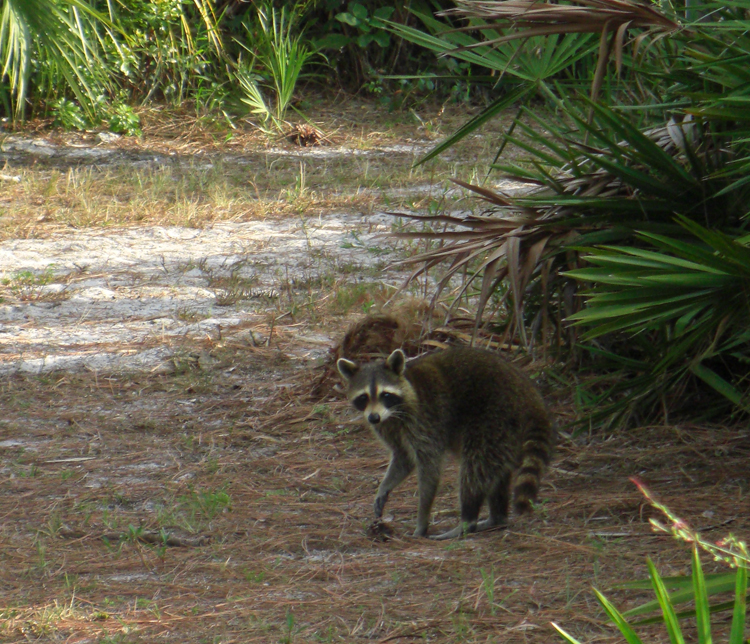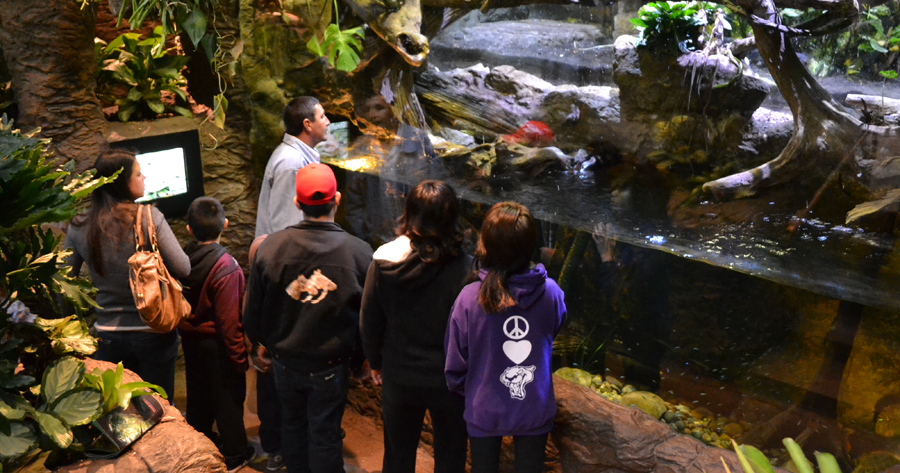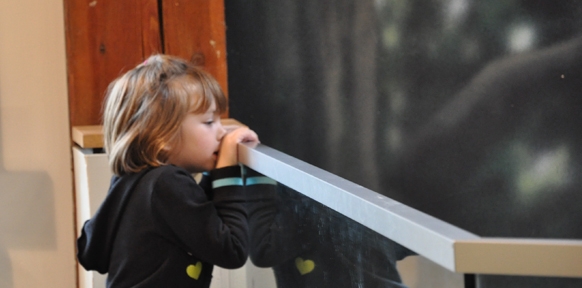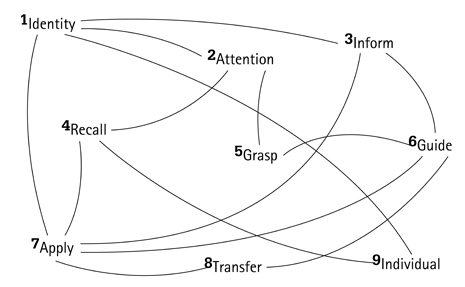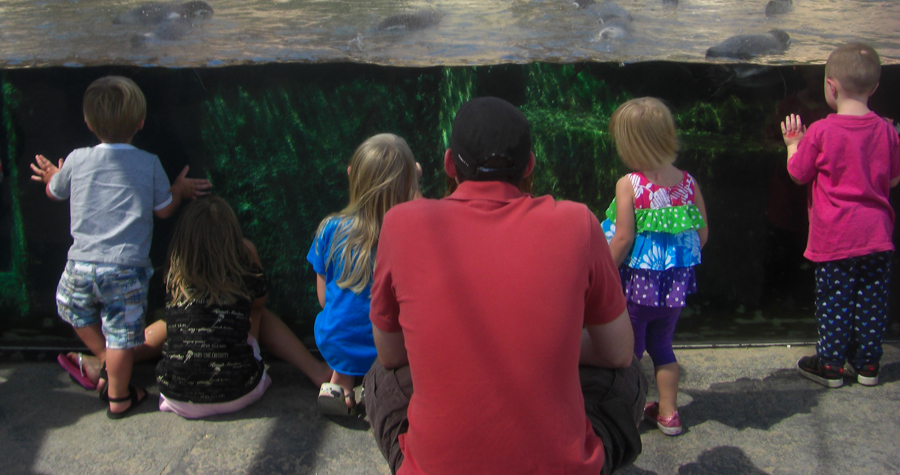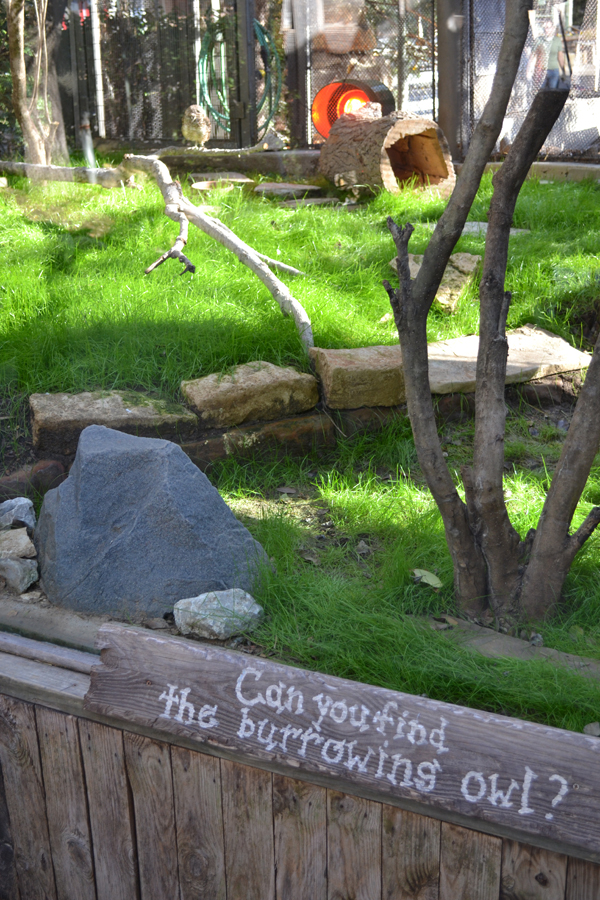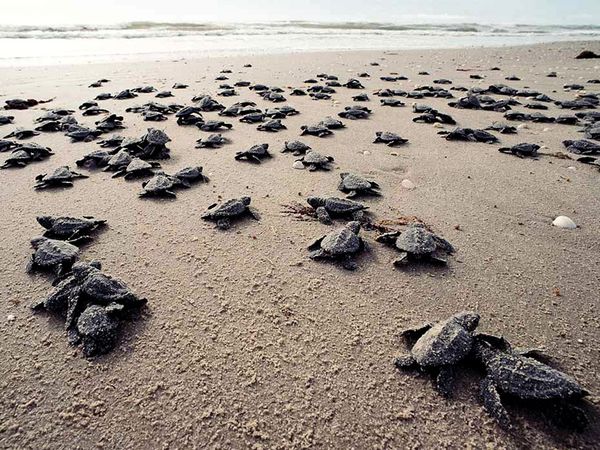My second Bemusement post for Blooloop is up and live here. Take a look and discover the growing trend that I feel will be one of the major innovations of zoos of the future. Mysterious enough for you? Here's a hint: I've brought it up several times on DZ before. But this time, I used some really rad throwbacks as metaphors. Check it!
Animal of the Month: Hippos
April showers bring May flowers, but here at DesigningZoos.com, April sea turtles bring May Nile hippos. Naturally.
The latest fact sheet focuses on everybody's favorite awkward-on-land-but-fierce-in-the-water mammal: the Nile Hippopotamus. Hippos live in groups of up to 30 animals and are extremely dangerous. They spend their days soaking in the water, but stretch their legs on the riverbanks to graze in the evenings. Because of this, DZ recommends you avoid that sunset walk along the banks of the Nile. Learn other important facts by checking out the Animal of the Month entry, here.
Happy 5th Anniversary!
Designingzoos.com Celebrates 5 Years of Exploring Zoological Design
Holy cats! I almost dropped my chai tea latte when I realized my very first post was five years ago today! So many things have changed...I've celebrated a full decade with PGAV Destinations, lived at 8 different addresses in 4 different cities, facilitated four successful master plans, participated in the opening of three new exhibit projects with two on their way soon, added a new fur baby and a collection of zoo and aquarium mugs, presented at three conferences, developed a professional development course for PGAV, became a blogger for Blooloop, wrote two novels, learned to play guitar and got a divorce. Phew! That's a lotta livin! And through it all, I managed to find time to dedicate to this little blog.
To celebrate our five years, I thought it might be fun to revisit some of the 165 posts of Designingzoos.com (that's an average of almost 1 per week!)--in case you accidentally missed one or two! And since it's our 5th anniversary, I thought I'd create some TOP 5 lists.
Top 5 Most Viewed Posts of All-Time
5. Multi-Disciplinary Integration...A Mouthful of Fun!
One of my personal favorites, this post explores a potential for the future of zoos--the merging of multiple tourism attractions into essentially a 'one stop shop' for edutainment.
4. New York Aquarium Facelift?
Perhaps because its been a long-time coming, or perhaps because it's about a beloved institution, but this post has been a popular one with those seeking insight into the forever looming redesign. After closing down due to extensive damage from Sandy, it is unclear to what extent the original plans will be instated. However, with the Aquarium now partially reopened, they've promised to move forward with its sharks exhibit.
3. Small and Sad: Dubai Zoo's Relocation on Hold Again
Similar to the NYA post, the constant promise and cancellation of this truly pathetic institution seems to be important to many readers. Rumors are always flowing about this one, and the current rumor is the project is once again a go.
2. The Next Zoo Design Revolution?
A highly controversial post generating wonderful discussion about the future of zoos. I'd argue, five years later, novelty-based design is, in fact, now on the cusp of full implementation (see Glacier Run, conceived to keep animals and people surprised and engaged; and the myriad possibilities for integration of interaction, including but not limited to digital technologies).
1. A Quick Lesson in Zoo Design History
The world must be full of history buffs! This post not only is the most viewed on DZ's site, but it has been viewed almost 3 times as much as the runner-up. Must be the Google search 'Zoos as Jails.'
Top 5 Editor's Picks
Sometimes you just gotta lay down some knowledge. This post is favorite of mine, because it explains to zoo-goers and professionals alike what that mysterious term 'master plan' means and how a successful one is created. I truly believe institutions must spend time developing a master plan, and this post tells you exactly why.
4. Video Games Get It...Do We?
Wow, this is an oldie--but a goodie! A fun read with some insight into my life outside of zoo design (and perhaps a hint into why my marriage is now defunct). Reveals how designers often look at the world--getting inspired in the most unexpected places. Although none of the design thoughts have been implemented in any way yet, tourism destinations are, in fact, starting to use game design theory to create experiences.
Storytelling is such a buzzword these days, but it truly is crucial to the development of a good exhibit experience. Once again, here I drew from an unexpected inspiration to provide insight into the art of zoo design. Also, I love Black Swan.
Not often do I broach a truly controversial subject on DZ, but the unwarranted uproar of animal activists got me all in a tizzy and I had to address it. This post is a not-so-strongly worded look at why zoo design can be a true moral and / or ethical challenge.
1. Inspiring Kids to Become Activists (AZA 2012, Day 3)
This is by far my favorite post. Not because it's ground-breaking or because it's so well written, but because the subject was so inspiring to me. I've always struggled with whether or not zoo experiences are truly making an impact on conservation, and through the development of this piece, I subsequently discovered an actual, plausible methodology to do so. Now, I just need a client willing to explore it with me...
Top 5 Site Visit Posts
5. DZ's First Zoo Review: The Mote Aquarium
My first and last zoo review. A failed experiment in site visits, this post is constructively critical with interesting tips and design insights, but perhaps a little too harsh. I do enjoy revisiting the post, though, as it reminds me how far we've come. And, I might add, how Mote has improved as well.
4. DZ Visits the Lemur Conservation Reserve
Visiting with lemurs in Florida had to make the list! What a special place helping to ensure the survival of some of my favorite species. The post includes some specific information regarding sizing for holding buildings that may come in handy.
3. Lincoln Park Zoo: Defining an Urban Zoo
One of my favorite posts as I had an epiphany about exactly how to review zoos. Subsequent to this visit, I also realized zoos come in one of four varieties: Urban Zoo, Suburban Formal, Suburban Park-like, or Natural Park-like. I like to categorize things, so this was a nice moment for me.
2. Minnesota Zoo: Be True to Yourself
Another great zoo review based more on 'the moral of the story is' rather than a critique. I also just really loved the Minnesota Zoo and have a real soft spot for zoos trying to succeed in a cold climate. Can't we get visitors to come in winter?? I think MZ's approach is just brilliant.
1. Underdogs: The Appeal of the Small Zoo
This might be a cheat since it covers multiple zoos and is one of my most recent posts, but I really do love small zoos. I love their design challenges--small site, small budget--and their big hearts. Not all small zoos are good zoos, but those doing it right, should really be congratulated.
I sure do hope you enjoyed this walk down memory lane. Cheers to everyone who's ever read the blog, especially those loyalists, to everyone who's ever helped me out with a contributing post or information, and here's to 5 more years!
If you would like to be a contributing blogger to DesigningZoos.com, please contact me using the form below. I'd like to keep a once weekly schedule, but often don't have the time, so if you have something you'd like to share regarding zoo and aquarium design, I'd love to hear from you!
[contact-form][contact-field label='Name' type='name' required='1'/][contact-field label='Email' type='email' required='1'/][contact-field label='Website' type='url'/][contact-field label='Comment' type='textarea' required='1'/][/contact-form]
Animal of the Month: Sea Turtles
Great news! I've added a page to the site dedicated to the Animal of the Month fact sheets. This month's addition: Sea Turtles!
You might know them as prototypical surfer dudes, but sea turtles are waaaaaay more than that. Did you know the largest sea turtles are the leatherbacks reaching upwards of 7' in length while the littlest ones, Kemp's Ridley, can be less than two feet! Sea turtles are mostly solitary, and females looking to lay their eggs typically return to the beaches where they were hatched. Wanna know more, like how big to a pool to make for 5 greens? Check out the Sea Turtles fact sheet here.
Aquarium Stats Resource
 A colleague just shared this amazing resource with me, so I'm passing it on to you. The Design Intelligence Almanac of Architecture and Design for 2013 lists North America's aquariums along with their size, cost and other information. A great reference for collecting bench marking data--a critical first step in many projects.
A colleague just shared this amazing resource with me, so I'm passing it on to you. The Design Intelligence Almanac of Architecture and Design for 2013 lists North America's aquariums along with their size, cost and other information. A great reference for collecting bench marking data--a critical first step in many projects.
The link is also available on our Resources page.
Mammoths at the Zoo?
Recently, I was invited to guest-blog over at Blooloop.com's site, Bemusement. Blooloop caters to the attractions industry as a whole, but is committed to increasing coverage of zoos and aquariums. Because many of Bemusement's readers are unfamiliar with the vast challenges facing zoos on a day-to-day basis, I wanted my first post to serve as a backgrounder on zoos while also addressing an interesting and timely topic, de-extinction. By examining de-extinction in the context of zoos, I found some interesting and unexpected corollaries between the two related, yet often ethically controversial, topics. Read my post at Bemusement here, and stay tuned for my monthly contributions.
Underdogs: The Appeal of the Small Zoo
I’ve always been partial to the underdog. Those whose beliefs and perseverance outweigh the skeptics' might by shear doggedness and tenacity. Those tirelessly working to do right despite just scraping by. I’m one of those people who gladly buys the opening band’s CD despite not having anything on which to play it. I always choose a local restaurant over a chain. My March Madness bracket is upset city, and I never liked that Michael Jordan.
The same is true for zoos and aquariums. Don’t get me wrong…I love the big guys and the top-notch experiences they offer. Their excellence in care, leadership in conservation and education, and ability to fill a day with shows, thematic exhibits and fun activity; the star species and large, diverse collections they maintain.
by Patrick Owsley
But there’s just something about the little guys. The ones caring for an oftentimes misfit collection of domestic goats, non-releasable hawks, three-strikes bears, confiscated leopards and donated snakes. Those whose skeleton staff, supported by an army of volunteers, work 18 hour days and happily offer up their own home as an impromptu nursery or quarantine area. Those zoos and aquariums whose budgets for capital improvements over the next 15 years barely equal the cost of a single exhibit at a world-renowned counterpart. The little guys. The underdogs.
So what constitutes an underdog zoo or aquarium? It’s something I’ve been thinking about a lot lately, but on which haven’t truly come to a conclusion. There’s something about its physical size—probably less than 35 acres; something to do with its attendance—maybe less than 100,000 annually; gotta’ include its capital expenditures, its market reach, its operating costs, its staff size and its collection size. But, really, there’s always going to be exceptions. What it comes down to is the feel. Just good ole’ fashioned, gut feeling. Like U.S. Supreme Court Justice Stewart famously said, “I shall not today attempt to further define {it}…But I know it when I see it.”
My love affair with the little guys probably began with my first real zoo job. I spent an undergrad summer bumbling through the construction of a Colobus monkey exhibit, part of the huge Africa expansion at the Binder Park Zoo. Flummoxed by construction documents my zoology classes hadn’t prepared me for, I found myself wandering the existing zoo grounds during lunches or after quitting time. I remember most the intimacy of visiting prairie dogs, digging through their dirt pile exhibit, interacting with the talking ravens, housed in a welded wire mesh aviary, and the simple beauty of exhibits carefully located between the towering old growth trees of the Michigan zoo’s deciduous forest. Even with the expansion, this zoo’s character is that of a walk in the woods; the African hoofstock and giraffes wandering the plains of a meadow that just happened to be there.
Similarly, the Central Florida Zoo, located just outside theme park mecca Orlando, takes advantage of its site to create more of an enhanced nature walk than the in-your-face, wholly man-made sensibility of a larger zoo. Rusticity is embraced and forgiven in a setting where you might expect to spot a free-ranging and truly wild alligator or Florida panther lurking in the swampy woods of the zoo grounds. This is a place where you know—from the moment you pull into the vehicular approach surrounded by the tunnel of live oaks dripping in Spanish moss-- to slow down, to take your time. You can see it all and do it all. There’s simply no rush.
Despite the Central Florida Zoo’s lack of both pathway hierarchy and organization based on distinctly defined regions (which do in fact seem to be defining characteristics of a small zoo), you won’t get lost. And so what if you pass by the porcupine exhibit two or three times in order to see the whole zoo. He’s sleeping conveniently in a location where you can get a good, close look at him. From the gravel parking lot and train ride outside the zoo gates to the elaborate spray pad surrounded by shaded seating, this zoo is quaint, and filled with an unmistakable sense of community. In this region, so ostentatiously built for tourism, this little zoo provides an escape to normalcy and a place for residents (and tourists alike) to enjoy a quiet afternoon in nature with family.
Perhaps the most meaningful zoo design experience I’ve had is with the Big Bear Alpine Zoo. PGAV’s partnership with the struggling Moonridge Zoo (as it is formerly known) began way back in 2005 when we interviewed in the beautiful San Bernardino Mountains in southern California. The existing zoo, which was the result of many years of dedicated work rehabbing the regions’ animals devastated by negative human interactions, is located on 2 acres in the parking lot of a local ski resort. The animals living here are non-releasable rehabs and confiscations, like Yoda, a Sawet owl, whose wing was amputated after being hit by a car. The animals are well-cared for, but the physical Zoo itself does not reflect the level of care and the conservation / education significance of the facility. Exhibits are chainlink and welded wire, crammed one after the other into its two acres.
We were hired to create a master plan and eventually to the design a wholly new zoo on a larger site, but still on a tight budget. And over the years, we’ve watched as the community support for the project has grown--despite bumps in the road. One day, the new zoo will be complete; the animals will have spacious new homes, the visitors will have an enriching experience, and I’ll be absolutely humbled to have been a small part of making a difference for such a worthwhile institution.
So, for me, the appeal of small zoos and aquariums stems from the fact that it seems, as designers, we can affect change the most at these institutions. These are facilities which rarely have capital for major physical changes. Places with big visions, but limited resources. These facilities need master plans not only for fundraising and planning purposes, but for the team building and strategizing they provide—for clarity of vision. They need experienced consultants that can offer creative and low-cost solutions to design issues; provide guidance on guest experience. Oftentimes, simple changes drastically affect the public perception of a place —and sometimes just the act of planning itself illustrates such commitment and resolve to achieve more that the zoo is elevated in the public’s eye. Many of today’s powerhouses began as just ‘a small zoo,’ but with the support of the community, were able to grow slowly and steadily over the years.
Do not overlook the little guys. Especially the little guys who’ve made the extra effort to become accredited by the AZA (or EAZA, IMATA, or AMMPA). This is an amazing feat for an institution of any size. And as we know, underdogs can impact the world just as mightily as the conventional leaders. We just need to give them a chance.
Interactivity and Zoos
A recent article by Wayne LaBar, the founder and principal at Alchemy Studios, outlined some of the growing trends in interactivity in museums...and got me to thinking: Are these also trends we are seeing in zoos and aquariums? If not, should they be? Certainly, interactivity in experience and educational opportunities are important aspects of zoo design. However, our industry may not lead the charge due to the simple fact that zoo visitors come to see animals primarily. Interactivity adds to the experience, elevates the excitement, and could serve as an educational platform, but in the end, guests would be happy just getting to see animals. Museums face a more difficult challenge in communicating often abstract concepts to their visitors without the benefit of a cute furry face, and thus seem to be the driving force of innovation on interactivity and interpretation in general.
Let's take a look at the current trends.
Certainly one of the largest movements occurring in children’s museums and science centers is the creation of Tinkering or Making spaces. This is a movement that originates from the work done by Make magazine and their affiliated “Maker Faires.” (www.makerfaire.com) As museums witnessed the creativity and the direct interaction that the public has with STEM (science, technology engineering and math) content, an essential need for museums to attract audience and funding, Tinkering/Maker spaces are popping up in many places. A Tinkering space is a place where visitors are allowed to build, create and tinker with low-end technology, use real tools and explore the concept of making something. These are usually staffed spaces although some are trying to explore minimizing staff engagement. Often, special events, fairs and other programs are being held in connection with these spaces. A key aspect of this is that these spaces do not require extensive design and development schedules and costs. They are a marriage of exhibit and program, where the activity is more important than the environment. The Exploratorium with their Tinkering Studio (blogs.exploratorium.edu/tinkering/) , New York Hall of Science who hosts the NYC Maker Faire and issued a report (www.nysci.org/learn/research/maker_faire_workshop) , and the Pittsburgh Children’s Museum MAKESHOP (pittsburghkids.org/exhibits/makeshop) are some of the leaders in this endeavor.
This one is somewhat limited in zoos and aquariums. I've heard about learning to basketweave or make jewelry and enrichment days where guests can make items for the animals (discussed further below), but generally the act of 'making' isn't the first thing that comes to mind when discussing the animal world. However, it is an interesting topic in that part of our challenge in zoo design is to create empathy. Many animals are, in fact, 'makers.' Birds build all sorts of nests in a variety of sizes, shapes and materials. Beavers make elaborate dams. Primates make and use tools. Even fish make nests! Why not create stations where these things can be experienced and explored in zoos?
Collaborative Exhibits & Events
In the constant search for innovative (yet budget-conscious) exhibits and interactivity, museums are increasingly looking to create ways in which people can interact by engaging with artists, groups and community organizations. Exhibitions based on this approach tend to have interactivity that may be more experimental or short-term, perhaps built around a weekend event or happening. A benefit of this type of low-impact interactivity is the opportunity to try things that are different and not necessarily built to the fabrication and durability standards that would define more traditional exhibits. Additionally, by reflecting engagement with community groups and other organizations, the exhibit becomes more social, and the social networks of these organizations, both physical and electronic, become engaged with the exhibits and potentially become part of the exhibitions themselves. One place exploring this direction is the Santa Cruz Museum of Art and History. Check out their event at (www.santacruzmah.org/events/) and read Nina Simon’s article in the latest NAME Exhibitionist issue.
The growing trend of Enrichment Days are what comes to mind in relation to collaborative events. Guests are encouraged to create and facilitate enrichment throughout the zoo, and in doing so, interact with keepers, docents and animals at a level not experienced on a normal trip to the zoo. I'm very curious about the effect of these special days as they exist now on visitor experience and how we can build from the basic idea to expand in a more socially engaging way as indicated by LaBar. Other events such as the now commonplace food / beer / music fundraising festivals (oftentimes called Zoofari) linger on the edge of being a collaborative event, but lack an integrated conservation / education message that could be leveraged during these gatherings.
New Interfaces
Certainly, an area that piques everyone’s interest in the interactivity field is devising new ways for people to engage with digital content or digital displays through more physical interfaces. We have seen a move away from the idea of keyboard-and-mouse to touchscreen to touch tables and now Kinect or Kinect-like interfaces. This outlines an evolution of the interface becoming more and more physical, more fully-body engaging and with more seamless physical/virtual experience. Over the past year, we have seen interest in new and innovative ways to engage people physically but also marrying that with digital content. Examples include the “Firewall” by Aaron Sherwood created in collaboration with Michael Allison, “Water Light Graffiti” done under the Digitalarti Artlab by the artist Antonin Fourneau, or the work done by ART+COM. In part, this is driven by the need for museums to provide experiences that cannot be duplicated at home. The interface advances also reflect the evolution of museum experiences moving into the home. These marriages of art, computer, physical world and content create interactivity and experiences that can’t be duplicated on your Xbox.
more fully-body engaging and with more seamless physical/virtual experience. Over the past year, we have seen interest in new and innovative ways to engage people physically but also marrying that with digital content. Examples include the “Firewall” by Aaron Sherwood created in collaboration with Michael Allison, “Water Light Graffiti” done under the Digitalarti Artlab by the artist Antonin Fourneau, or the work done by ART+COM. In part, this is driven by the need for museums to provide experiences that cannot be duplicated at home. The interface advances also reflect the evolution of museum experiences moving into the home. These marriages of art, computer, physical world and content create interactivity and experiences that can’t be duplicated on your Xbox.
 Interfaces are all over the map in zoos and aquariums. Partially due to the lack of budget and partially due to durability issues, zoos and aquariums vary in their usage of technology. Aquariums, with their somewhat controlled indoor environment, seem to be much more willing to embrace such things as touchscreens (seen in Georgia Aquarium as far back as 2005) and full-body Kinect-like interfaces. As technology moves forward--driving prices down and durability up, I am confident we'll see an increase in these creative interfaces not only for interpretation at zoos and aquariums but also as part of the general guest experience.
Interfaces are all over the map in zoos and aquariums. Partially due to the lack of budget and partially due to durability issues, zoos and aquariums vary in their usage of technology. Aquariums, with their somewhat controlled indoor environment, seem to be much more willing to embrace such things as touchscreens (seen in Georgia Aquarium as far back as 2005) and full-body Kinect-like interfaces. As technology moves forward--driving prices down and durability up, I am confident we'll see an increase in these creative interfaces not only for interpretation at zoos and aquariums but also as part of the general guest experience.
And what about the interactivity of animals and people? This has been a growing trend in zoos and aquariums over the past decade with the increasing popularity of swim-with dolphins and sea lions, lorikeet nectar feeding and ray touches among many others. These 'responsible' interactions are only going to become more prevalent.
Mobile Individuality
The world of mobile computing has been transformed over the past five years with the increasing size of and sophistication of smart phones, the acceptance of tablets, and the growing ubiquity of internet access through cellular plans or freely available wifi. Museums were quick to adopt these technologies as part of the visitor experience, and now they have become almost a necessary part of interactivity strategy for an exhibition or institution. Despite this, the field still struggles with what is the best way to use these technologies and how to integrate them into the exhibition form. For some collections-based exhibitions, they may be the principle interactivity, while a device at an interactive exhibition might actually be an obstacle to visitor experience. As our field continues to explore how to best apply new technologies, some of the more exciting experiments relate to how these devices might personalize everyone’s experience. For example, work is ongoing on enhancing personal instruction as part of school trips, accessing data through NFC technology, and integrating augmented reality into an experience. This personalization will certainly be another ongoing trend in interactivity over the coming year and beyond. Check out work being done at the Minnesota Historical Society in their Education Department with their new exhibition Then Now Wow (minnesotahistorycenter.org/exhibits/then-now-wow) with school groups talked about , The Australian Museum and the work lead by Lynda Kelly (australianmuseum.net.au/staff/lynda-kelly) and the Science Museum of London and their augmented reality with James May (www.sciencemuseum.org.uk/visitmuseum/jamesmay).
Similar to the interface issue, mobile media is on the cusp of exploding onto the zoo and aquarium front. Most zoos acknowledge the desire to tap into this resource--the ability to enhance a visitor's experience through augmented reality as well as provide deeper educational options to those that are interested in lieu of physical graphics / signage--but are limited by the steep initial cost of development. The upside to the cost, however, is once the initial programs are developed, costs are limited to content creation--the same as would be with any other technology, and the operational costs will be much less than most conventional (physical) content delivery methods. Plus, content can be changed out immediately for a fresh and repeatable experience.
zoos acknowledge the desire to tap into this resource--the ability to enhance a visitor's experience through augmented reality as well as provide deeper educational options to those that are interested in lieu of physical graphics / signage--but are limited by the steep initial cost of development. The upside to the cost, however, is once the initial programs are developed, costs are limited to content creation--the same as would be with any other technology, and the operational costs will be much less than most conventional (physical) content delivery methods. Plus, content can be changed out immediately for a fresh and repeatable experience.
Balancing Education and Entertainment in Zoo Design
By Cray Shellenbarger Zoo design is as difficult a task as any. We attempt to set criteria based upon needs of animals, visitors, zoo staff and zoo administrators. One of the biggest issues I see is the balance between education and entertainment. Zoos generally advertise themselves as promoting education and conservation, but as designers we cannot forget that a large number of attendees come to be entertained. It is the job of the design team to educate the public about conservation and the individual animals in a variety of creative ways. Oftentimes, it is better to be subtle with our techniques so that patrons do not feel that they are being bombarded with information. I believe that by creating more immersive, interactive and technologically advanced exhibits we can achieve the goal of educating the public, and perhaps pick up a few added benefits along the way.
By creating an immersive, realistic environment for both the animal and the guests, the exhibit is passively conveying information. By incorporating lifelike materials with ambient sounds and water as appropriate, the guest is gaining an understanding of the animal’s habitat and ultimately its place in the ecosystem. The guest can be provided a few visual cues to make points, instead of being forced to read text. These exciting elements may have a better chance of sticking with the guest compared to text that is often passed by. Materiality is also very important in immersive environments. By incorporating real rock, landscape or sand as opposed to murals or other less genuine methods, the guest can better understand the environment. Obvious barriers can also inhibit the engagement between animals and guests. Hiding these within landscape can add to the sense of immersion and, ultimately, optimize the educational experience.
Creating an immersive exhibit will provide the animal with a more natural environment. Along with naturally appropriate enrichment techniques, we can begin to correctly portray the animal’s native behavior. Enrichment ideas and any necessary training should avoid anthropomorphizing of animals as much as possible. Many people associate animal’s behaviors with human behaviors and emotions when these, depending on the animal may be very different.
Along the same lines as immersive exhibits, I think it is of great importance to include as many interactives as possible. Humans learn by doing. If we can provide some kind of activity that indirectly exposes the user to information about animals or conservation it will be successful. These can range from touch experiences to puzzle type exhibits. I think that zoos see the importance in these now, but by adding more, we can really enrich the educational and entertainment experience simultaneously. A recent example is a high-tech exhibit touch screen wall at the Pittsburgh Zoo.
The last and arguably most important aspect is our fast growing mobile technology. I think it is imperative that we begin to capitalize on the interconnectivity of nearly every zoo guest. It is rare to see a visitor without a smart phone or tablet. Some theme parks have already begun to incorporate applications that can be loaded onto these devices to engage and interact with the guest. One example is the application that Sea World Orlando launched for its Turtle Trek attraction. This interactive game allows users to portray the characters and create a personalized experience.
This idea can be utilized from more than one angle. Ads and sponsorship could be incorporated to help cover the initial cost of launching as well as produce continued revenue generation over time. The application could also help motivate guests to explore exhibits outside of the big attractors. This would have an effect on guest flow, but could help balance the people per minute at any one exhibit. Educational elements of this kind should be incorporated as well. There are countless ideas that could be incorporated that could help balance education and entertainment while generating additional revenue for the zoo.
By building immersive, interactive, and technologically advanced exhibits, we can further engage the guest. This engagement comes with the added benefit of conveying more knowledge while creating a more entertaining experience and generating revenue. The emerging technology is a powerful tool that we should use to our advantage. The Zoo is constantly advancing, both from a guest and business perspective. The zoos of today are very different from 60 years ago, and they will no doubt be vastly different 60 years from now.
Cray Shellenbarger is from central Illinois and attended Southern Illinois University earning both Bachelor's and Master’s degrees in Architecture. His thesis focused on human perception of space, specifically in regards to religious architecture. In his short time at PGAV, Cray has worked on a variety of projects at PGAV including several animal habitats. cray.shellenbarger@pgav.com
Visitors: An Overlooked Species at the Zoo
By Eileen Ostermeier
Zoos have long been at the forefront of animal research, but only recently have they started conducting studies on another important but relatively overlooked species: their visitors. For decades, museums, science centers, theme parks and National Parks have been studying their visitors – long before the practice was seen as useful in the zoo world. Yet in this age of information, with competing attractions vying for attention, visitor studies are more useful than ever. Moreover, ever-accelerating technological advances and new methods of gathering and analyzing data have made it possible for Zoos to gain a greater understanding of their visitors than ever before. But more research on visitors is needed, generated not just by Zoos and their umbrella organizations (like the AZA) but also by zoo designers themselves.
Why Conduct Visitor Studies?
Why should zoos and related organizations study zoo visitors? Organizations (like the AZA and EAZA) that are dedicated to the advancement of zoos should use visitor studies to evaluate whether and how zoos are meeting the broad goals of conservation, research, education and recreation. The AZA recently conducted a broad, multi-institutional study, Why Zoos & Aquariums Matter: Assessing the Impact of a Visit to a Zoo or Aquarium (AZA, 2007), which focused on the impact of zoos on conservation knowledge, attitudes and behavior. In essence, such studies help justify the existence of zoos. Individual zoos, meanwhile, should study visitors to measure the impact of their messaging and to evaluate whether their institution is meeting its stated goals. And from a practical standpoint, zoos could use visitor studies to increase revenue generation and to improve the economics of zoo business.
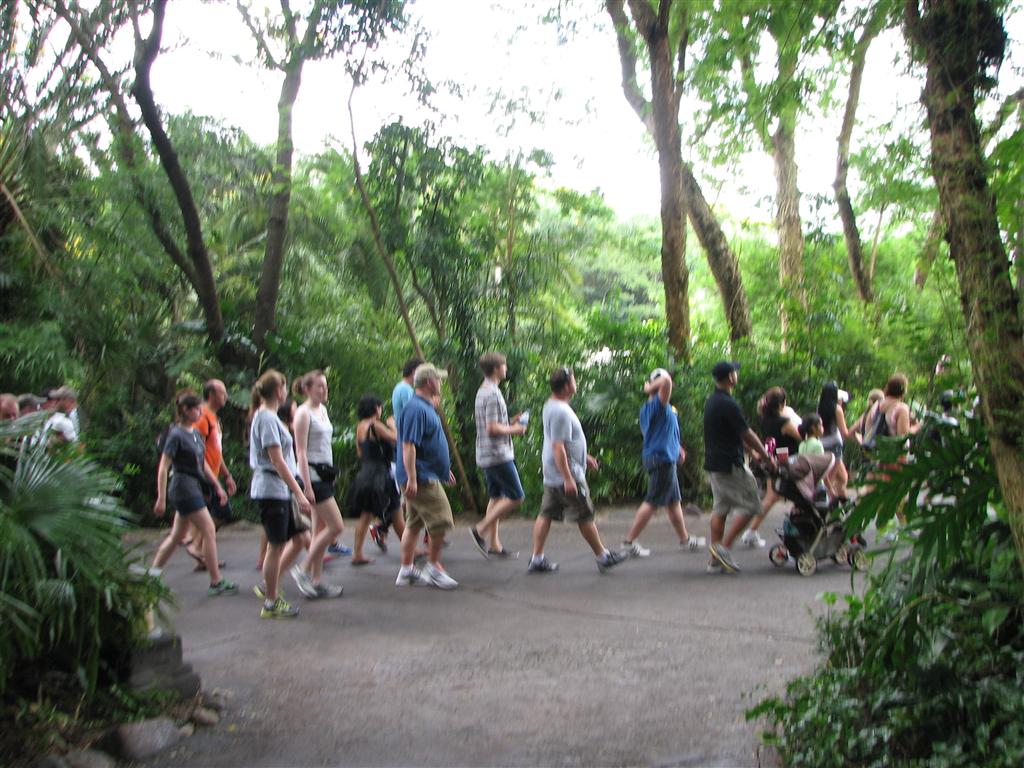 But what about the role of zoo designers? Traditionally, most visitor research has been conducted by the institutions themselves. Recently, however, designers are taking a more active role in studying how visitors behave in and respond to zoo exhibits. PGAV Destinations, for example has not only conducted market research on zoo visitors but has also sent its designers into the field to conduct timing and tracking studies on zoo visitors. Fueled with hard data and facts from their studies, designers are making more-informed decisions about exhibit design. Moreover, such studies can inform all stages of design, from early concept work and master planning to the detailed design of specific exhibit elements. Visitor studies allow designers to more-fully understand the impact of various factors on visitor behavior. For example: designers might test the impact of path width on crowd movements and density, or the correlation between the length of a viewing window and length of stay, and so on. Visitor studies also help set realistic expectations about visitor response to new exhibits (dwell time, level of engagement, etc.). In fact, the predictive power of visitor studies is arguably their most useful benefit. Visitor studies can be used not only to test design decisions and to determine the relative success of existing exhibits but also (and perhaps more importantly) to inform the design of future exhibits.
But what about the role of zoo designers? Traditionally, most visitor research has been conducted by the institutions themselves. Recently, however, designers are taking a more active role in studying how visitors behave in and respond to zoo exhibits. PGAV Destinations, for example has not only conducted market research on zoo visitors but has also sent its designers into the field to conduct timing and tracking studies on zoo visitors. Fueled with hard data and facts from their studies, designers are making more-informed decisions about exhibit design. Moreover, such studies can inform all stages of design, from early concept work and master planning to the detailed design of specific exhibit elements. Visitor studies allow designers to more-fully understand the impact of various factors on visitor behavior. For example: designers might test the impact of path width on crowd movements and density, or the correlation between the length of a viewing window and length of stay, and so on. Visitor studies also help set realistic expectations about visitor response to new exhibits (dwell time, level of engagement, etc.). In fact, the predictive power of visitor studies is arguably their most useful benefit. Visitor studies can be used not only to test design decisions and to determine the relative success of existing exhibits but also (and perhaps more importantly) to inform the design of future exhibits.
What Studies Exist?
 Who can we learn from? Historically, museums, science centers and National Parks have conducted detailed visitor studies. In fact, much of the current information regarding visitor behavior is taken from the museum world, where researchers are constantly evaluating the success of their exhibitions. Further afield, researchers should learn not only from the work of traditional research outlets (like educational psychology, sociology, and environmental science) but also from more unexpected disciplines (like marketing and consumer research). As an example: one researcher noted the similarity of zoo visitor studies to his own research on shopping behavior in grocery stores (Yalowitz & Bronnenkant, 2009). Finally, Theme Parks and similar entertainment destinations – with particular strengths in quantifying visitor flow, tracking & timing, and revenue generation – are a vast and relatively untapped resource in the Zoo world.
Who can we learn from? Historically, museums, science centers and National Parks have conducted detailed visitor studies. In fact, much of the current information regarding visitor behavior is taken from the museum world, where researchers are constantly evaluating the success of their exhibitions. Further afield, researchers should learn not only from the work of traditional research outlets (like educational psychology, sociology, and environmental science) but also from more unexpected disciplines (like marketing and consumer research). As an example: one researcher noted the similarity of zoo visitor studies to his own research on shopping behavior in grocery stores (Yalowitz & Bronnenkant, 2009). Finally, Theme Parks and similar entertainment destinations – with particular strengths in quantifying visitor flow, tracking & timing, and revenue generation – are a vast and relatively untapped resource in the Zoo world.
In the past couple of decades, Zoos have started conducting their own visitor studies. Organizations have begun compiling resources and developing literature reviews, like Visitor Learning in Zoos and Aquariums: A Literature Review (Dierking, Lynn, et al, 2001-2002). Of particular note is a recent, comprehensive, multi-institutional and cross-discipline effort by the EAZA to compile a list of relevant visitor studies: Looking at People Looking at Animals: An International Bibliography on Visitor Experience Studies and Exhibit Evaluation in Zoos and Aquariums (EAZA Education Committee, 2011). A particular strength of current studies is the focus on interpretation, education, and the impact of conservation messaging on zoo visitors.
What Studies Should Be Conducted?
Because of their unique position in the Zoo world, groups like the AZA and EAZA should be conducting visitor studies that play to their strengths as broad, multi-institutional organizations. Such groups should conduct more comprehensive, nationwide or international surveys that bridge the gaps between separate Zoos. These should include literature reviews, bibliographies, and cross-institutional visitor studies. Such studies would be particularly useful for comparing the relative success of exhibits at different institutions and for identifying key trends across several Zoos. They may also serve to establish methodological standards and to encourage Zoos to conduct more detailed studies of their own institutions.
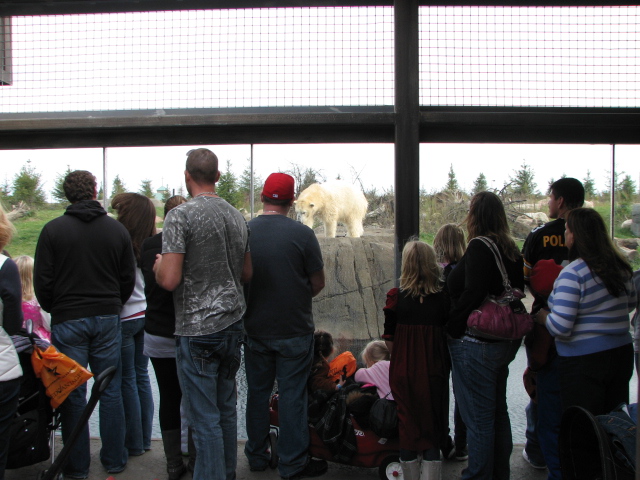 Zoos, meanwhile, should be harvesting a wealth of information about their visitors, with a particular focus on the unique circumstances at their specific institution. It is important for Zoos to understand what makes their zoo different from others – variables ranging from the demographic make-up of its visitors and its region to the institution’s focus, goals, strengths and challenges. What works at one Zoo (e.g. a new polar bear exhibit that draws new visitors by the thousands) does not always work at another. Uniquely positioned to study their visitors, Zoos should use all the resources at their disposal – from the ability to track operational data like hourly attendance and revenue to the dozens of staff and volunteers eager to help.
Zoos, meanwhile, should be harvesting a wealth of information about their visitors, with a particular focus on the unique circumstances at their specific institution. It is important for Zoos to understand what makes their zoo different from others – variables ranging from the demographic make-up of its visitors and its region to the institution’s focus, goals, strengths and challenges. What works at one Zoo (e.g. a new polar bear exhibit that draws new visitors by the thousands) does not always work at another. Uniquely positioned to study their visitors, Zoos should use all the resources at their disposal – from the ability to track operational data like hourly attendance and revenue to the dozens of staff and volunteers eager to help.
But Zoos and their umbrella organizations are not the only groups who should study zoo visitors. Zoo designers should be conducting visitor studies as well. Such studies should be targeted and detailed, focusing on a specific factor, variable or design criteria the zoo designers wish to better understand through data and facts. For example, Zoo designers may wish to study the impact of exhibit temperature (say, at indoor cold-weather penguin exhibits) on dwell time, level of engagement, and walking speed. Or they may study the impact of the size of an underwater viewing window on the length of stay and the number of viewers the window can reasonably accommodate at any given time. Likewise for other factors like water clarity, animal activity, path width, type of interpretive elements, level of cultural theming, and the like. Studying the impact of specific design variables should inform future design decisions and lead to better understanding of what makes an exhibit successful. Tracking and timing studies – those that focus on factors like dwell time, crowd flow, level of engagement, etc. – are particularly useful for designers. But few zoo designers are currently studying visitors. Those that are have a distinct advantage over their counterparts.
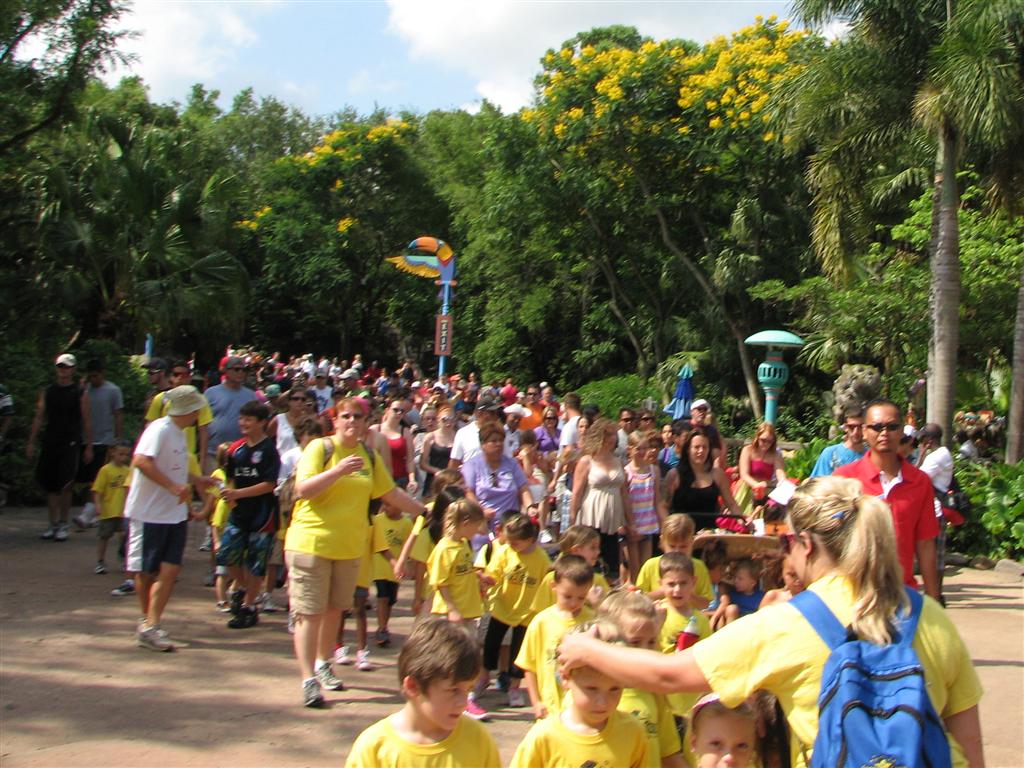 Issues
Issues
Despite the recent insurgence of zoo visitor studies, the field is plagued by a number of issues. Studies are done sporadically by separate institutions, which are sometimes reluctant to share their results. Those that are published are often difficult to compare, due to inconsistent criteria, small sample sizes, and idiosyncratic results (usually resulting from poor study design). This is particularly problematic when trying to evaluate the relative success of different exhibits at different institutions. Fortunately, several researchers have made recommendations regarding methodology and indicators for comparison – including dwell time and the Sweep Rate Index (SRI), which standardizes for different exhibit sizes (Yalowitz & Bronnenkant, 2009).
A bigger issue may be that most of the current research is focused on visitor education, to the neglect of other, important areas. Though a lofty goal, Zoo visitor research should focus on more than just conservation messaging. Besides asking what their visitors are learning, Zoos should also ask questions like: “How can we improve the visitor experience beyond communicating our message? How well are we entertaining as well as educating? Are we generating sufficient revenue to meet our future goals?” Revenue generation, though perhaps less esteemed than interpretation and messaging, is absolutely essential for the Zoo to meet its other goals. Detailed visitor studies can inform everything, from dining menus and the location of food carts or retail (e.g. was that gift shop at the end of the exhibit useful?), to opportunities for high-end experiences, like tours and one-on-one interactive experiences with animals. And most importantly, Zoos should be asking “What’s next?” and looking to the future, of not just their institution but of zoo design itself.
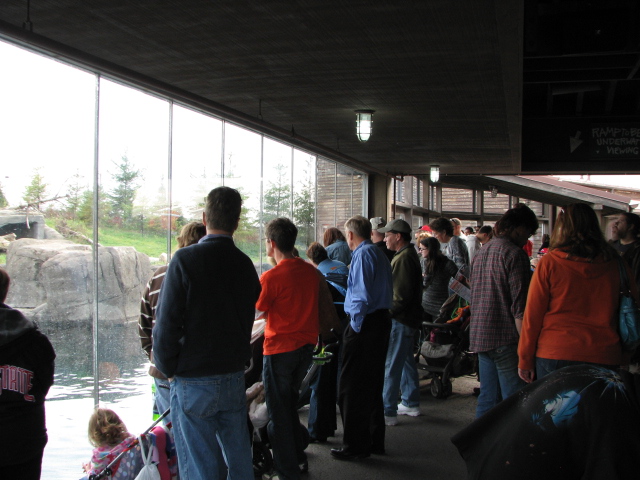 Trends and the Future of Visitor Studies
Trends and the Future of Visitor Studies
Researchers of visitor behavior should look to the future for new ideas, including new methods of collecting and analyzing data. Technology is increasingly being used as a tool for understanding visitor behavior. Researchers can now use videotaping, hand-held digital devices or software systems for recording and analyzing data (including the Noldus Observer and the Museum Experience Recorder system). Taking this a step further, the Walt Disney Company has reportedly invested more than $1 billion on its so-called “Next Generation Experience” project, a technology and marketing initiative focused on detailed visitor tracking and data-mining. Soon, all visitors to Walt Disney World will wear RFID bracelets throughout the resort, allowing the company to collect detailed data on individual spending habits, crowd movements and more – a literal “marketing bonanza” (Garcia, 2013). What’s next? Eye-tracking software to analyze visitor interest (Ross & Wagner, 2012), or personalized itineraries that visitors can create on digital mobile devices? The possibilities are endless.
Ultimately, designers should take a much greater role in conducting visitor studies. Designers may think they know what constitutes good zoo design, but they should confirm their assumptions and back them up with data and facts. The best way to do this is to conduct detailed studies of zoo visitors and factors that impact their designs. There is enormous potential to benefit from the wealth of information out there, just waiting to be collected, analyzed and understood. Designers should take the lead in studying the visitors that come to their Zoos.
Bibliography
Association of Zoos & Aquariums. "Why Zoos & Aquariums Matter: Assessing the Impact of a Visit to a Zoo or Aquarium." 2007. Association of Zoos & Aquariums. Web. 27 December 2012. <http://www.aza.org/uploadedFiles/Education/why_zoos_matter.pdf>.
Dierking, Lynn, et al. "Visitor Learning in Zoos and Aquariums: A Literature Review." 2001-2002. International Zoo Educators Association. Web. 27 December 2012. <http://www.izea.net/education/AZA-Visitor_Leaning_in_Zoos_Aquraiums_Literature_Review.pdf>.
EAZA Education Committee. "Looking at People Looking at Animals: An International Bibliography on Visitor Experience Studies and Exhibit Evaluation in Zoos and Aquariums." February 2011. European Association of Zoos and Aquaria. Web. 27 December 2012. <http://www.eaza.net/activities/education/Documents/2011-02-10%20Visitor%20Studies%20Bibliography%20%20V0.3.pdf>.
Francis, David, Maggie Esson and Andrew Moss. "Following Visitors and What It Tells Us: The Use of Visitor Tracking to Evaluate ‘Spirit of the Jaguar’ at Chester Zoo." 2007. International Zoo Educators Association. Web. 27 December 2012. <http://www.izea.net/education/journal%202007%20following%20visitors%20and%20what%20it%20tells%20us.pdf>.
Garcia, Jason. "Orlando Sentinel." 2013 7 January. Disney reveals NextGen details with 'MyMagic+'. Web. 7 January 2013. <http://www.orlandosentinel.com/the-daily-disney/os-disney-reveals-next-gen-details-20130107,0,6117836.story>.
Ridgway, Stephanie Clark, Margaret Livingston and Steven E. Smith. "Visitor Behavior In Zoo Exhibits With Underwater Viewing." Visitor Studies Today 2005: 1, 3-10. Web. 27 December 2012. <http://ag.arizona.edu/research/azalfalf/pdf_pubs/zoo_visitor_behavior.pdf>.
Ross, Steve and Kathleen Wagner. "Visitor Behavior in Zoos and Aquariums." Connect: Association of Zoos & Aquariums May 2012: 42-43. Print.
Yalowitz, Steven S. and Kerry Bronnenkant. "Timing and Tracking: Unlocking Visitor Behavior." Visitor Studies 12.1 (2009): 47-64. Web. 2012 27 December. <http://www.tandfonline.com/doi/pdf/10.1080/10645570902769134>.
Eileen Ostermeier studied architecture at Washington University in St. Louis and later received her Masters in Landscape Architecture from The Ohio State University, where she focused on habitat design and restoration. She has been with PGAV for 4 years and is currently working on Safari Africa! at the Columbus Zoo. eileen.ostermeier@pgav.com
Study Shows Captive Dolphins Benefit from Interaction Programs & Shows
The perceived high level of intelligence in dolphins often makes them the center of controversy, especially in relation to captivity. Recently, the activism spotlight has focused on the horrific practices in Japanese fishing town, Taiji, where pods of cetaceans, including pilot whales and bottlenose dolphins, are driven into a 'killing lagoon' for slaughter or collection by marine life facilities. This purported 'tradition' was featured in an Oscar winning documentary (which I haven't brought myself to watch--not enough Kleenex in this world...) several years ago called The Cove, and continues to make headlines (especially on social media like Twitter) as awareness increases.
 The secondary goal of the Taiji hunts--collecting specimens for dolphinariums and theme parks--often brings the issue of captivity, in general, under scrutiny. While I personally do not condone the taking of any animals from the wild--except in extreme cases where the animal will otherwise perish--and I believe the practice to be quickly dying away, many equate all captive facilities with the Taiji methods. Many activists make the wild leap from speaking out against Taiji to boycotting responsible facilities such as SeaWorld (who, I should note, does a lot of good for wild animals through solid and widespread rescue and rehab efforts). In doing so, captive collections are unjustly brought under fire--and with dolphins specifically, the issue of interaction programs (such as swim-withs and touches) and shows are often cited as deplorable.
The secondary goal of the Taiji hunts--collecting specimens for dolphinariums and theme parks--often brings the issue of captivity, in general, under scrutiny. While I personally do not condone the taking of any animals from the wild--except in extreme cases where the animal will otherwise perish--and I believe the practice to be quickly dying away, many equate all captive facilities with the Taiji methods. Many activists make the wild leap from speaking out against Taiji to boycotting responsible facilities such as SeaWorld (who, I should note, does a lot of good for wild animals through solid and widespread rescue and rehab efforts). In doing so, captive collections are unjustly brought under fire--and with dolphins specifically, the issue of interaction programs (such as swim-withs and touches) and shows are often cited as deplorable.
I am here to set the record straight.
A recent study published in Animal Welfare examined the effects of shows and interaction programs on 18 Atlantic bottlenose dolphins in six facilities across the U.S. The study clearly indicated that these programs did not produce deleterious effects on the dolphins; in fact, the study found an increase in positive behaviors indicating interaction programs and shows are actually beneficial to captive dolphins. "The increases in behavioural diversity, variation in swimming style, activity levels and play behaviour following both types of programmes are likely a result of the complexity, unpredictability and choices afforded to the animals during these programmes." In other words, much like the findings in a similar study on giraffe feeding, these programs are enrichment opportunities for the dolphins.
 Please note that the participating institutions are all accredited by the AZA, IMATA, and / or Alliance of Marine Mammal Parks & Aquariums--an important distinction indicating these facilities abide by the strictest of standards for responsible husbandry of the animals in their care. If you'd like to boycott facilities, I suggest you boycott those who do not meet these standards or refuse to comply.
Please note that the participating institutions are all accredited by the AZA, IMATA, and / or Alliance of Marine Mammal Parks & Aquariums--an important distinction indicating these facilities abide by the strictest of standards for responsible husbandry of the animals in their care. If you'd like to boycott facilities, I suggest you boycott those who do not meet these standards or refuse to comply.
If you'd like to read the study, please use the links above to request a copy from the publisher.
Design Resource No Longer Available
 Today, to my dismay, I discovered the WAZA website has been updated to remove all sizing and enrichment recommendations from the once-excellent Virtual Zoo. This resource was great as it collected recommendations from around the world, including AZA and EAZA resources into one simple reference. I'm not sure why the information was deleted, but assume it was due to the work involved in collecting and maintaining the data. If anyone can direct us designers to another resource, especially for the oft overlooked non-mammalian species, please let me know! What a sad day for me...
Today, to my dismay, I discovered the WAZA website has been updated to remove all sizing and enrichment recommendations from the once-excellent Virtual Zoo. This resource was great as it collected recommendations from around the world, including AZA and EAZA resources into one simple reference. I'm not sure why the information was deleted, but assume it was due to the work involved in collecting and maintaining the data. If anyone can direct us designers to another resource, especially for the oft overlooked non-mammalian species, please let me know! What a sad day for me...
2012: A Year in Zoo Review (and Aquariums, too!)
The new year is just around the corner and like so many, I've put together a list of the year's highlights--from a zoo design perspective. So, on this final Friday of 2012, grab a cup of joe, tea, or a good ole fashioned flute of champagne and follow along as we recount the opening of permanent exhibits across the U.S. in 2012.
Dallas Zoo's Koala Walk-About
Opened in March, the koala habitat--one of only 10 in the US--anchors a series of Australian exhibits including a lorikeet feed.
L.A. Zoo's LAIR (Living Amphibians, Invertebrates, & Reptiles)
Opened in March, this extensive indoor / outdoor exhibit is one of few major new exhibits in many years to focus entirely on the 'creepy crawlies' of the zoo--attempting to make stars out of those species often overlooked.
Tulsa Zoo's Helmerich Sea Lion Cove
Opened in March, the completely re-vamped exhibit area features an integrated demonstration theater.
SeaWorld Orlando's Turtle Trek
Opened in April, this innovative exhibit and 3D theater experience is a renovation of the existing manatee and turtle exhibits that concisely and powerfully delivers a critical conservation message: You can be an everyday conservation hero.
Tennessee Aquarium's River Giants
Opened in April, the 90,000 gallon freshwater exhibit renovation--converted from a saltwater tank--features species that grow to enormous sizes.
Akron Zoo's Journey to the Reef
Opened in May, the collection of aquatic exhibits replaced a temporary jelly exhibit and features a ray touch pool.
Aquarium of the Pacific's June Keyes Penguin Habitat
Opened in May, the habitat provides above and below water viewing for the Aquarium's 12 new Magellanic penguins.
Toledo Zoo's Tembo Trail
Opened in May, the African complex is anchored by a major renovation to the elephant exhibit including improved visitor viewing and greater enrichment opportunities for the animals.
Cincinnati Zoo's Cat Canyon
Opened in June, the exhibit features updated homes for tigers, cougars and snow leopards, and eventually achieved Gold LEED status.
Denver Zoo's Toyota Elephant Passage
Opened in June, the innovative 10-acre exhibit is built for up to 8 bull elephants, along with many other Asian species, and features a series of yards--including an overhead transfer bridge--with a deep pool for full submersion. The exhibit also utilizes Timed Entry--limiting visitor capacity--to ensure a great guest experience.
Saint Louis Zoo's Sea Lion Sound
Opened in June, Sea Lion Sound features an entirely new exhibit--featuring a 'never-before-seen for sea lions' walk-thru tube--and large integrated show amphitheater.
Utah's Hogle Zoo's Rocky Shores
Opened in June, the entirely new exhibit area, anchored by polar bears with underwater viewing, features species new to the zoo including bears, otters and seals.
Discovery Cove's Freshwater Oasis
Opened in June, this new freshwater experience replaces the original Tropical Reef and features in-water viewing of marmosets and small clawed river otters.
Knoxville Zoo's Valley of the Kings
Opened in August, the revamped lion exhibit enriches the habitat and increase visibility for the guests. Baboons were also brought back to the zoo.
Philadelphia Zoo's Great Ape Trail
Opened in August, the first phase of the first-of-its-kind trail system allows apes to traverse the zoo through a system of overhead mesh tunnels.
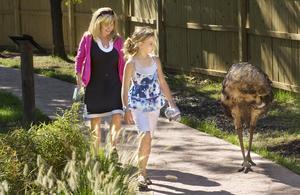 Peoria Zoo's Australia Walk-About
Peoria Zoo's Australia Walk-About
Opened in August, the new Australia exhibit allows a barrier-free experience among emu, swan, wallabies and budgies.
National Zoo's American Trail
Opened in September, this series of exhibits completely revamped the existing North America section of the zoo, and features a large sea lion exhibit with demonstration area.
Central Florida Zoo's Otter Exhibit
Opened in September, the lovely exhibit with partial underwater viewing is a true jewel for the small, local zoo.
Cosley Zoo's Bobcat Exhibit
Opened in September, the 20' tall exhibit for a pair of bobcats marks the first major capital investment for the tiny zoo in twenty years.
Fresno Chaffee Zoo's Sea Lion Cove
Opened in September, the zoo's new home for their 3 sea lions and 2 seals caused record attendance for Labor Day weekend.
Minnesota Zoo's Black Bear Exhibit
Opened in September, the naturalistic bear exhibit marks the completion of the Minnesota Trails exhibit complex update.
Oklahoma Aquarium's Extreme Amazon
Opened in November, this small exhibit allows guests to pop-up into the habitat of iguanas and Amazonian fish.
Did I miss any? Let me know by commenting below.
Wishing everyone a Happy Zoo Year!
Why Master Plan?
A few months ago, I visited with a potential client--who will remain unnamed-- dealing with a complicated case of left-overs. An older institution with aging and non-immersive exhibits, a disconnected and fragmented campus, and plans in the works for a sister institution. As we toured the facilities, the director, aware of experiential and logistical issues of his multi-faceted campus, asked how I could help with one specific exhibit. I smiled and indulged him in some top-of-the-head design suggestions about visibility and theming, but ended by asking, “And what are your plans for this space?” (indicating the mostly unused plaza surrounding the exhibit). “Well, we’re not sure. We want to change it all. Eventually.”
I dropped my notebook to the floor and screamed, “Stop! Don’t touch this exhibit until you develop a master plan!” I didn’t really do that. But I wanted to.
What I did do was explain the importance of master planning. Master plans are essential to the long-term success of zoos and aquariums. They are tools for exploring and pinpointing issues. They are compasses to keep your staff on track. They are road maps for the future.
But why, you ask. Why do we master plan?
To answer the why, let’s look at the how. Generally, master plans are led and completed by zoo designers, and should include three parts: Analysis, Product Development and Implementation Planning. Each phase sets the stage for the next.
In Analysis, we look at as many aspects of the park as possible, from your market and penetration to building condition. We pour over visitor surveys, attendance and revenue records. We inspect each exhibit and every building. We talk to staff from maintenance to keepers to administrators. We gather and analyze, zeroing in on things that you’re doing well and things that are issues. At the end of Analysis, we create a set of overriding Goals and Strategies for the extent of the master plan.
The Goals are big. Increase attendance. Become world leaders in conservation. Educate our guests. The Strategies are much more specific—and in direct response to the Analysis.
For example, if our goal is to create a financially sustainable organization, some strategies may include adding a new dining facility, increasing appeal of special events rental facilities, or creating budget-friendly new attractions.
These Goals and Strategies inform and guide the Product Development process; they pinpoint specific tasks to be achieved, specific projects to be created. And in the Product Development stage, we delve into these projects. We brainstorm and explore multiple options for projects—creating many more ideas than what we could feasibly achieve in the master plan period. With these options in hand, we systematically evaluate each through the filter of the master plan goals—which often includes market testing. At the end of the Product Development phase, we’ll have a list of selected projects with conceptual storylines, plans, sketches, imagery and rough estimates.
With these projects defined, we finish the master plan by completing an Implementation plan. This phase allows us to understand ‘how’ to get these projects instated. We create a phasing plan—when will each project be rolled out?—and a funding plan—how much capital will the zoo need to raise by what dates? Finally, we create illustrative site plans defining what the zoo will look like at determined intervals (ie every 1, 3, or 5 years).
At the end, the zoo will walk away with a comprehensive plan to achieve specific goals over a set timeline. Generally, master plans plan 10-15 years out. Of course, things come up and even the best laid plans get waylaid. These surprises are exactly why master plans are so important. Because we spent so much time creating the guiding Goals and Strategies, any new issue that comes up should be tackled through the same lenses as the planned projects. Of course, Goals and Strategies may be adjusted over the years, but if the zoo finds their strategic outlook has changed dramatically from the master plan…it’s time to master plan again!
“The Master Plan gave us direction to accomplish these goals and puts us on the path to creating a more enjoyable, interactive and rich experience for the future,” said Stuart Strahl, director of Brookfield Zoo.
Finally, master plans are critical for zoos to move forward—logistically. Through a master plan, zoos have specific projects to show off, to fundraise for. The master plan provides essential visual and verbal descriptions that get the market excited and motivated to give. Not only that, the master plan is a concise definition of who the zoo is (brand today), and where they want to go (brand tomorrow). It’s a great handbook for employees, and a wonderful platform for marketing.
If your zoo doesn't have a master plan, or its master plan is out of date, the best time to start a new one is right now.
Learning in Zoos: Design Guidelines, Part 3
By Russell Ploutz Example projects
To understand how to apply the nine principles and fifty-three guidelines, I designed seven example projects. The projects illustrate how the design guidelines coalesce to create a cognitive experience and shape the exhibit form. For each of the example projects, illustrations and narratives explain how the exhibit engages and facilitates visitor’s learning processes following the design guidelines. Projects like Who is Right?, Help the Otters, and Two Waterways describe exhibit concepts and possible design strategies for using the guidelines such as comparison, decision-making and action-taking.
One example project, Four Lives, centers on the activity of role playing and decision-making. First, visitors choose to be a farmer, poacher or ranger and throughout the exhibit experience situations and information specific to their character. In some situations they make decisions applying their prior knowledge, information presented in the exhibit and their emotions by reacting to the situation affecting their character. The exhibit facilitates the decision-making process by stimulating recall with design elements, guiding understanding with trained actors and engaging advanced cognitive processes. To enable their application of knowledge, the visitor circulation is a network of pathways where at each junction visitors choose a path linked to their decision. The chosen path leads visitors to a new situation embodying the consequence of their decision, providing feedback on their application of learning.
Design Manual
I compiled the example projects, guidelines and background information into an interactive digital document. The interactivity reflects the complexity and interconnected process of learning by providing hyperlinks to related information using a navigation bar. The bar helps the reader navigate the complexity and make connections between related concepts, guidelines and example projects.
Overall, the design manual presents a vision of increased visitor engagement and greater influence of exhibits on learning. It demonstrates how the program, exhibit organization and spatial characteristics can affect visitor’s learning processes. Additionally, the document raises questions about the design approach and extra design processes needed in the design of zoo exhibits for learning. Ultimately, the guidelines have the potential to provide new visitor experiences and design strategies which engage learning processes, helping to achieve zoo’s goal of conservation.
If you are interested in the other example projects, learning more about cognitive processes, and how exhibits can facilitate learning feel free to contact me at russell.ploutz@gmail.com.
Learning in Zoos: Design Guidelines, Part 2
By Russell Ploutz After recalling prior knowledge and preparing visitors for learning, the exhibit and included activities can facilitate learning processes by employing the following principles to improve understanding.
5. Grasp - capitalize on concrete experiences.
The Grasp principle describes how exhibits can most effectively leverage the unique experiences people come to zoos for - personal experiences with animals and nature. Exhibits can use concrete experience to help visitors understand abstract concepts such as ecological processes, critical to understanding zoo’s messages. The principle describes how to coordinate the presentation of abstract concepts with concrete experiences and vice versa.
6. Guide - facilitate meaning-making.
Exhibits can also assist visitors in understanding new information by guiding them in the meaning-making process. The Guide principle describes how exhibits can facilitate understanding with visitor activities and exhibit situations by stimulating additional cognitive processes.
7. Apply - reinforce learning with application.
After understanding new information, exhibits can encourage visitors to use their new knowledge to reinforce the learning. By applying information in new situations visitor’s understanding strengthens with increased contextualization. The Apply principle describes design strategies for visitor activities and exhibit situations promoting application of learning.
8. Transfer – connect information to other situations.
Similarly, the Transfer principle explains how learning is a continual process where people use information from previous experiences and in future ones - the learning experience is but one point in time. This principle explains how exhibits can embrace the dynamic process of learning by making connections to other situations outside of the immediate exhibit context.
9. Individual - facilitate different learning preferences.
The Individual principle describes how the learning process is unique to different visitors. We each have personal preferences for learning and since we control what we engage in zoos, exhibits need to reach the largest audience possible by appeal to many different types of visitors. The principle explains how to employ our choice and control to increase understanding by designing for each of Gardner’s Multiple Intelligences.
Part 3 in Russell Ploutz's series...
Learning at Zoos: Design Guidelines, Part 1
We at DesigningZoos.com always love guest bloggers and new, insightful information. So when former PGAV intern, Russell Ploutz, offered to share his thesis project on learning in zoos, I jumped at the chance to share his brilliance with the world. He has summarized his extremely in-depth and thoughtful project for us, and I'll be posting it via 3 installments. Without further adieu... Cognitive Based Zoo Design Guidelines by Russell Ploutz
What is learning?
Learning is the process of transforming information into knowledge using cognitive processes - the “mental process that individuals undergo as they think, learn, and perform problem-solving and decision-making activities.” If humans use predictable processes during learning, how can zoo exhibits engage those processes to improve visitor learning? Insights from cognitive psychology provide guidance for how to facilitate human learning processes, creating fulfilling visitor experiences while achieving zoos’ mission of education.
By researching the fundamentals of learning I developed a set of design guidelines for zoo exhibits which stimulate and facilitate visitor’s learning processes. I created the design guidelines by gathering professional zoo designer’s input, reviewing literature and personal findings resulting in a design manual for engaging cognitive processes. The manual contains three elements: background information synthesizing literature specific to zoo exhibit designers, design guidelines for engaging learning processes and, example projects I designed illustrating the application of the guidelines.
Learning Principles
Fifty-three design guidelines are grouped into nine principles addressing different aspects of learning. Each learning principle contains related guidelines and background information which ground the guidelines in scientific studies. Additionally, the principles contain methods and potential design strategies for employing the design guidelines.
The first principles describe prerequisite cognitive processes to engage prior to transforming information into knowledge. Meeting these initial principles is critical because without their provision learning is unlikely to occur.
1. Identity - learning needs to fulfill our motivations.
For learning to succeed in places like zoos where we control how and what we engage, we need to want to learn. The Identity principle builds on Falk’s work on Visitor Identities describing visitor’s motivations and needs. The principle explains how to fulfill each visitor’s Identity by productively satisfying their social and personal needs with learning opportunities.
2. Attention - we must engage the exhibit.
Once visitors are motivated to engage in learning, then exhibits can assist visitors in focusing on learning content. For learning to occur, we must direct our attention in the exhibit to acquire information. The Attention principle describes how exhibit characteristics can direct visitor’s attention on learning content to engage the information.
3. Inform - we need to know how to engage.
In addition to directing visitor’s attention on learning content, exhibits also need to inform visitors as to how they can engage in learning. If we do not know how to engage the exhibit, how can we learn from the exhibit? The Inform principle explains how exhibits can directly and indirectly notify visitors of learning opportunities.
4. Recall - we use prior knowledge with new information.
Once visitors are prepared to learn the exhibit can facilitate one of the most critical aspects in learning, the recall of prior information and experiences. We use our past experiences to understand new information and situations through contextualization. This principle explains how exhibit elements and design characteristics can evoke past memories helping visitors understand new information.
AZA 2012 Day 5: Small Zoos, Big Conservation Impacts
My last day at the conference. I'll admit I was up too late sharing cocktails with colleagues the night before, and the intensity of the conference was starting to catch up with me. But I persisted--and managed to squeeze in one last session before running to the airport and to sweet, sweet sleep. The session was a humdinger--indirectly addressing the ever-present question: Why do zoos matter?
 Small zoos (in terms of operating budget) face bigger challenges than their larger sisters. Smaller budgets, more intense competition, smaller markets, less respect and higher scrutiny. But in the face of these challenges, many small zoos still include conservation programs as their highest priorities. In fact, some might say, due to these challenges--lack of respect and increased scrutiny, to be specific--small zoos MUST prioritize conservation.
Small zoos (in terms of operating budget) face bigger challenges than their larger sisters. Smaller budgets, more intense competition, smaller markets, less respect and higher scrutiny. But in the face of these challenges, many small zoos still include conservation programs as their highest priorities. In fact, some might say, due to these challenges--lack of respect and increased scrutiny, to be specific--small zoos MUST prioritize conservation.
 Gladys Porter Zoo, Brownsville, TX (I had to look it up) is one such institution who's taken conservation programming to the next level, despite their size. For over 20 years, the Zoo has not only supported, but created and run a Kemp's Ridley sea turtle program in Mexico. The zoo employs one staff member full time to run the program, in addition to a second staffer dedicated to all other conservation programs. The Zoo earmarks $650,000 every year for this single program, which over the span of the program, has helped protect over 70,000 nests and 4.5 million hatchlings.
Gladys Porter Zoo, Brownsville, TX (I had to look it up) is one such institution who's taken conservation programming to the next level, despite their size. For over 20 years, the Zoo has not only supported, but created and run a Kemp's Ridley sea turtle program in Mexico. The zoo employs one staff member full time to run the program, in addition to a second staffer dedicated to all other conservation programs. The Zoo earmarks $650,000 every year for this single program, which over the span of the program, has helped protect over 70,000 nests and 4.5 million hatchlings.
Dallas World Aquarium similarly helped found the Amazon Rescue Center, a private-public partnership in Peru, principally focusing on Amazonian Manatee conservation. The Aquarium raises over $400,000 annually to support their work along with several other Central and South American conservation programs. Dr. Luis Sigler, senior conservation biologist, believes conservation programs should be run like businesses in order for them to thrive.
So, how can a small zoo or aquarium be expected to create and fund a great project if they find themselves scraping for pennies as it is? Steve Burns, director of ZooBoise, explained how they managed it. Slowly. Starting with a single conservation parking meter, ZooBoise raised $1500 annually. From there, they added a $0.25 conservation 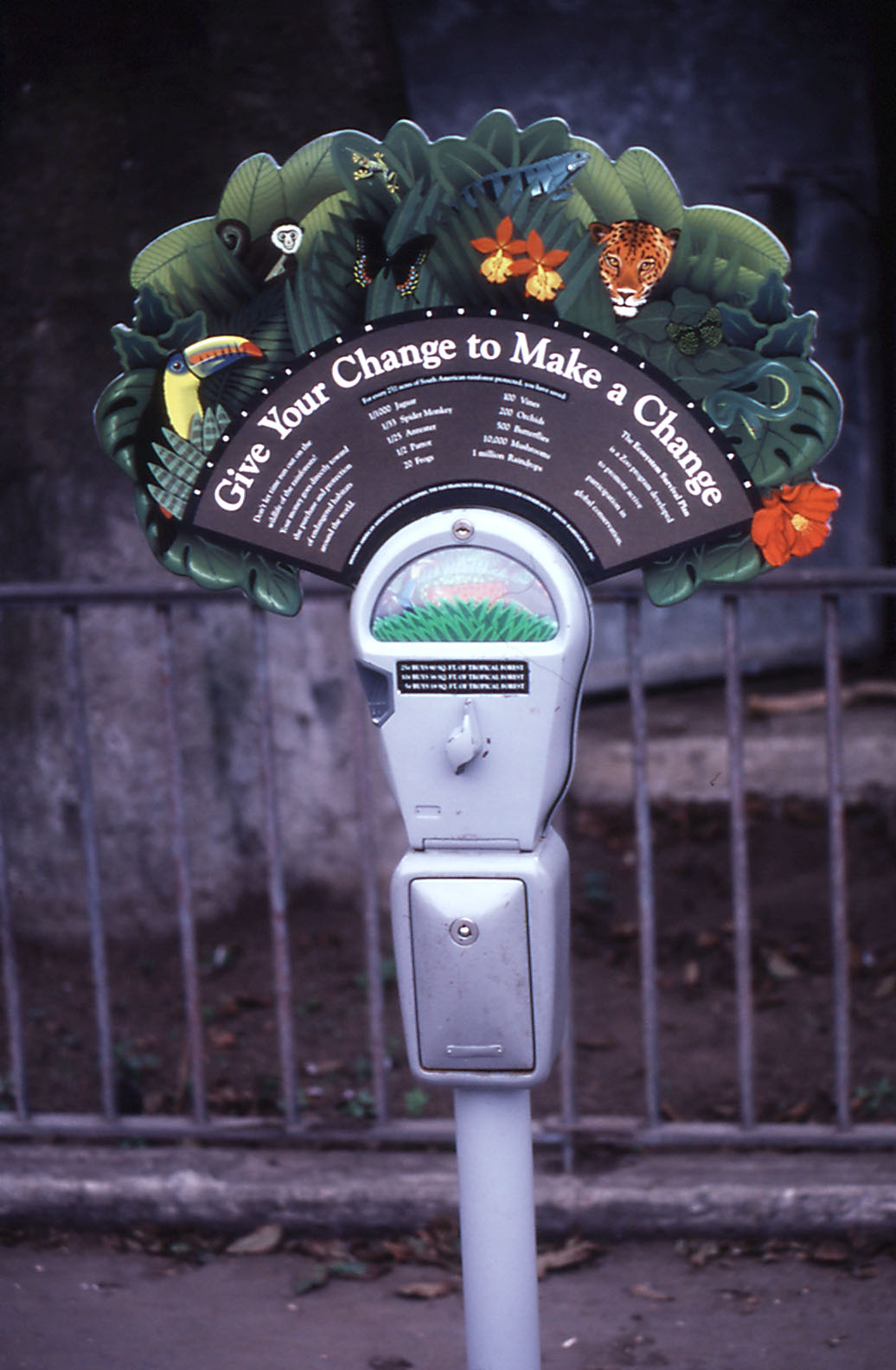 fee onto admission. The fee raised $57,000, and the Zoo recorded two complaints. So they raised it again--by a dime, and increased their conservation collection by $23,000. Now they had the ball rolling. They added a series of fee-based 'special experiences,' including sloth bear feeding, with all of the funds going directly to conservation programs. Currently, they require every new capital campaign to include an additional 10% to go directly to conservation. So that new otter exhibit with a $500,000 price tag now requires $550,000 to be raised. ZooBoise now expects to raise over $200,000 annually for conservation.
fee onto admission. The fee raised $57,000, and the Zoo recorded two complaints. So they raised it again--by a dime, and increased their conservation collection by $23,000. Now they had the ball rolling. They added a series of fee-based 'special experiences,' including sloth bear feeding, with all of the funds going directly to conservation programs. Currently, they require every new capital campaign to include an additional 10% to go directly to conservation. So that new otter exhibit with a $500,000 price tag now requires $550,000 to be raised. ZooBoise now expects to raise over $200,000 annually for conservation.
What does your small zoo or aquarium do for conservation? And how do we let our public know how much good they are doing by supporting zoos? Voice your opinion!
September Animal of the Month: Snow Leopard
 The Snow Leopard generally leads a solitary and snowy life among the rocks of the Himalayan mountains. Learn more about them by signing up to receive the PGAV Destinations Animal of the Month fact sheets by contacting me directly.
Check out a past fact sheet here.
The Snow Leopard generally leads a solitary and snowy life among the rocks of the Himalayan mountains. Learn more about them by signing up to receive the PGAV Destinations Animal of the Month fact sheets by contacting me directly.
Check out a past fact sheet here.
Inspiring Kids to Become Activists (AZA 2012, Day 3)
 After a wonderful Icebreaker on Monday night (Sept. 10) at the Arizona Science Center (where Dave and I survived a hurricane and a volcano eruption), the Tuesday morning general session officially kicked-off the conference. During this session, we were treated to a rousing presentation by Marc Kielburger, co-founder of Free the Children, an international human rights organization based in Canada.
Free the Children is an inspiring organization in its own right--empowering children to help other children across the globe. The organization was originally created by Marc's younger brother after he traveled to South Asia to investigate child labor--when he was 12! But, that's only part of why Marc was at AZA 2012.
After a wonderful Icebreaker on Monday night (Sept. 10) at the Arizona Science Center (where Dave and I survived a hurricane and a volcano eruption), the Tuesday morning general session officially kicked-off the conference. During this session, we were treated to a rousing presentation by Marc Kielburger, co-founder of Free the Children, an international human rights organization based in Canada.
Free the Children is an inspiring organization in its own right--empowering children to help other children across the globe. The organization was originally created by Marc's younger brother after he traveled to South Asia to investigate child labor--when he was 12! But, that's only part of why Marc was at AZA 2012.
Free the Children and sister organization, Me to We, have figured out how to motivate children, especially teenagers, to not only become interested in world issues, but to become activists for their favorite causes. A challenge we in the zoo and aquarium industry are constantly facing (with kids, sure, but also with adults!).
Marc described their philosophy with 5 key bullet points.
1. Make it Cool to Care
Although Marc prefaced this by pointing out that children today are much different than those even 10 years ago--when apathy was the IN thing (Did you see the 21 Jump Street movie this summer? Yeah, that's what he's talking about.)--kids still want to feel like they are part of the in-crowd. Like they sit at the cool table in the cafeteria. And they feel this way when all their friends are doing something, and even more so, when that something is endorsed by all the It celebrities. Yes, we're talking Justin Bieber, Demi Lovato, Magic Johnson, Jennifer Hudson, and--always popular with the kiddies--Mikhail Gorbachev, among many, many others. Marc's organizations make it cool by putting on exuberant, over-the-top, arena-sized kid-travaganzas, called 'We Days', featuring inspiring talks and rocking musical performances that can only be attended by children who meet the activism and volunteer eligibility requirements. These events are experiences that kids look forward to and work hard for. Things kids brag about attending. Things the cool kids do-- in other words, 'incentives.'
2. Gift + Issue = Change
Everyone has something they are good at, whether its baking cupcakes, drawing unicorns, or selling tires. Identifying your strength is the first step to becoming an activist. Getting kids involved means helping them identify their own gift. It also means helping them understand how they can apply their gift to support an issue that is dear to them. Once that connection is realized, anyone, including children, can confidently take action to initiate change. And according to Kielburger, activism can be as small as a bake sale.
3. Call a Minga
Kielburger explained a ‘minga’ as a coming together of many to the benefit of all. It is a Chilean word with, ironically, no direct equivalent in the English language. He described the scene when he first experienced a minga—after the village elder woman yelled the word across a canyon in the Andes and a congregation of strangers from the surrounding hills showed up to help out—without explanation, without question. This feeling of support, of community is something that most of us long for—including our kids. This generation, more so than any in recent memory, are aching to be a part of something larger than themselves. To do for others in need, even as many themselves are struggling.
4. Changing Perspectives
Remember the saying, “If you could walk a mile in their shoes”? First-hand experience is the absolute best way to understand an issue. In order to inspire, to motivate, kids need to participate, to experience, to see with their own eyes. Me to We provides these experiences for young people, bringing them to remote villages in need of help--taking children to Africa to build schoolhouses, or carry jugs of water two miles each way so mothers can spend a day with their children. Authentic, in-the-field experiences that really enforce what they've learned at home. Kielburger believes these are life-altering, formative experiences that create fundamental and lifelong activists.
5. Keep it Social
This one’s simple: keep the activism where the kids are…online. Kielburger stressed that kids don’t read email anymore. They live on Facebook, on Twitter, on Tumblr. If you want to communicate with them, utilize their favorite forms, and reach them in their own language.
 So the question is now…how do we translate these bullet points into campaigns that zoos and aquariums can use? Can we link these to the physical design of a place, or are we moving more into a place where educational outreach and programming is the only means to create activists? Personally, I think the physical zoo experience is the foundation for creating activists. The first step, the platform from which we jump off—not only with kids but with adults too. Get their attention, provide the base info, then provide a means to take action. The zoo itself is the means to bring issues to the table. To make people aware. Encouraging them to take action will require more than a physical exhibit. It will require partnerships and programming. It also requires taking chances and getting creative.
So the question is now…how do we translate these bullet points into campaigns that zoos and aquariums can use? Can we link these to the physical design of a place, or are we moving more into a place where educational outreach and programming is the only means to create activists? Personally, I think the physical zoo experience is the foundation for creating activists. The first step, the platform from which we jump off—not only with kids but with adults too. Get their attention, provide the base info, then provide a means to take action. The zoo itself is the means to bring issues to the table. To make people aware. Encouraging them to take action will require more than a physical exhibit. It will require partnerships and programming. It also requires taking chances and getting creative.
What do you think?









